This pipeline computes the correlation between cancer subtypes identified by different molecular patterns and selected clinical features.
Testing the association between subtypes identified by 12 different clustering approaches and 11 clinical features across 525 patients, 39 significant findings detected with P value < 0.05 and Q value < 0.25.
-
CNMF clustering analysis on array-based mRNA expression data identified 3 subtypes that do not correlate to any clinical features.
-
Consensus hierarchical clustering analysis on array-based mRNA expression data identified 7 subtypes that correlate to 'Time to Death', 'NEOPLASM.DISEASESTAGE', 'GENDER', and 'RACE'.
-
3 subtypes identified in current cancer cohort by 'Copy Number Ratio CNMF subtypes'. These subtypes correlate to 'NEOPLASM.DISEASESTAGE', 'PATHOLOGY.T.STAGE', and 'PATHOLOGY.M.STAGE'.
-
3 subtypes identified in current cancer cohort by 'METHLYATION CNMF'. These subtypes correlate to 'NEOPLASM.DISEASESTAGE', 'PATHOLOGY.T.STAGE', 'PATHOLOGY.M.STAGE', and 'GENDER'.
-
CNMF clustering analysis on RPPA data identified 6 subtypes that correlate to 'NEOPLASM.DISEASESTAGE', 'PATHOLOGY.T.STAGE', and 'PATHOLOGY.M.STAGE'.
-
Consensus hierarchical clustering analysis on RPPA data identified 3 subtypes that correlate to 'Time to Death', 'NEOPLASM.DISEASESTAGE', 'PATHOLOGY.T.STAGE', and 'PATHOLOGY.M.STAGE'.
-
CNMF clustering analysis on sequencing-based mRNA expression data identified 3 subtypes that correlate to 'NEOPLASM.DISEASESTAGE', 'PATHOLOGY.T.STAGE', 'PATHOLOGY.M.STAGE', and 'GENDER'.
-
Consensus hierarchical clustering analysis on sequencing-based mRNA expression data identified 3 subtypes that correlate to 'NEOPLASM.DISEASESTAGE', 'PATHOLOGY.T.STAGE', 'PATHOLOGY.N.STAGE', 'PATHOLOGY.M.STAGE', and 'GENDER'.
-
3 subtypes identified in current cancer cohort by 'MIRSEQ CNMF'. These subtypes correlate to 'NEOPLASM.DISEASESTAGE', 'PATHOLOGY.T.STAGE', and 'GENDER'.
-
4 subtypes identified in current cancer cohort by 'MIRSEQ CHIERARCHICAL'. These subtypes correlate to 'NEOPLASM.DISEASESTAGE', 'PATHOLOGY.T.STAGE', 'PATHOLOGY.M.STAGE', and 'GENDER'.
-
4 subtypes identified in current cancer cohort by 'MIRseq Mature CNMF subtypes'. These subtypes correlate to 'PATHOLOGY.M.STAGE' and 'RACE'.
-
3 subtypes identified in current cancer cohort by 'MIRseq Mature cHierClus subtypes'. These subtypes correlate to 'PATHOLOGY.M.STAGE', 'GENDER', and 'RACE'.
Table 1. Get Full Table Overview of the association between subtypes identified by 12 different clustering approaches and 11 clinical features. Shown in the table are P values (Q values). Thresholded by P value < 0.05 and Q value < 0.25, 39 significant findings detected.
|
Clinical Features |
Time to Death |
AGE |
NEOPLASM DISEASESTAGE |
PATHOLOGY T STAGE |
PATHOLOGY N STAGE |
PATHOLOGY M STAGE |
GENDER |
KARNOFSKY PERFORMANCE SCORE |
NUMBERPACKYEARSSMOKED | RACE | ETHNICITY |
| Statistical Tests | logrank test | Kruskal-Wallis (anova) | Fisher's exact test | Fisher's exact test | Fisher's exact test | Fisher's exact test | Fisher's exact test | Kruskal-Wallis (anova) | Kruskal-Wallis (anova) | Fisher's exact test | Fisher's exact test |
| mRNA CNMF subtypes |
0.257 (1.00) |
0.873 (1.00) |
0.00606 (0.497) |
0.00843 (0.666) |
0.0704 (1.00) |
0.12 (1.00) |
0.632 (1.00) |
0.00758 (0.606) |
0.315 (1.00) |
||
| mRNA cHierClus subtypes |
2.96e-06 (0.000368) |
0.168 (1.00) |
0.00054 (0.0502) |
0.004 (0.336) |
0.1 (1.00) |
0.0107 (0.821) |
7e-05 (0.007) |
1e-05 (0.00123) |
0.471 (1.00) |
||
| Copy Number Ratio CNMF subtypes |
0.442 (1.00) |
0.0569 (1.00) |
3e-05 (0.00312) |
3e-05 (0.00312) |
0.0102 (0.796) |
0.00043 (0.0404) |
0.00438 (0.364) |
0.414 (1.00) |
0.506 (1.00) |
0.0125 (0.936) |
0.732 (1.00) |
| METHLYATION CNMF |
0.582 (1.00) |
0.00693 (0.562) |
1e-05 (0.00123) |
1e-05 (0.00123) |
0.25 (1.00) |
0.00014 (0.0136) |
3e-05 (0.00312) |
0.367 (1.00) |
0.672 (1.00) |
0.026 (1.00) |
1 (1.00) |
| RPPA CNMF subtypes |
0.0393 (1.00) |
0.173 (1.00) |
1e-05 (0.00123) |
1e-05 (0.00123) |
0.013 (0.952) |
1e-05 (0.00123) |
0.102 (1.00) |
0.109 (1.00) |
0.112 (1.00) |
0.352 (1.00) |
|
| RPPA cHierClus subtypes |
2.35e-05 (0.00247) |
0.111 (1.00) |
1e-05 (0.00123) |
1e-05 (0.00123) |
0.0539 (1.00) |
1e-05 (0.00123) |
0.104 (1.00) |
0.0648 (1.00) |
0.849 (1.00) |
0.0664 (1.00) |
|
| RNAseq CNMF subtypes |
0.0137 (0.989) |
0.16 (1.00) |
1e-05 (0.00123) |
1e-05 (0.00123) |
0.0125 (0.936) |
0.00169 (0.15) |
2e-05 (0.00214) |
0.554 (1.00) |
0.541 (1.00) |
0.033 (1.00) |
0.122 (1.00) |
| RNAseq cHierClus subtypes |
0.019 (1.00) |
0.162 (1.00) |
1e-05 (0.00123) |
1e-05 (0.00123) |
0.00114 (0.104) |
0.00187 (0.165) |
0.00012 (0.0118) |
0.198 (1.00) |
0.88 (1.00) |
0.0333 (1.00) |
0.756 (1.00) |
| MIRSEQ CNMF |
0.042 (1.00) |
0.0281 (1.00) |
0.00038 (0.0361) |
0.00078 (0.0718) |
0.0119 (0.907) |
0.00335 (0.285) |
0.00247 (0.212) |
0.777 (1.00) |
0.591 (1.00) |
0.299 (1.00) |
0.224 (1.00) |
| MIRSEQ CHIERARCHICAL |
0.104 (1.00) |
0.0704 (1.00) |
2e-05 (0.00214) |
8e-05 (0.00792) |
0.0194 (1.00) |
0.00027 (0.0259) |
0.00137 (0.123) |
0.156 (1.00) |
0.884 (1.00) |
0.14 (1.00) |
0.0181 (1.00) |
| MIRseq Mature CNMF subtypes |
0.633 (1.00) |
0.68 (1.00) |
0.343 (1.00) |
0.116 (1.00) |
0.172 (1.00) |
1e-05 (0.00123) |
0.0251 (1.00) |
0.994 (1.00) |
1e-05 (0.00123) |
0.454 (1.00) |
|
| MIRseq Mature cHierClus subtypes |
0.43 (1.00) |
0.0614 (1.00) |
0.342 (1.00) |
0.0441 (1.00) |
0.16 (1.00) |
6e-05 (0.00606) |
0.00216 (0.188) |
0.843 (1.00) |
1e-05 (0.00123) |
0.387 (1.00) |
Table S1. Description of clustering approach #1: 'mRNA CNMF subtypes'
| Cluster Labels | 1 | 2 | 3 |
|---|---|---|---|
| Number of samples | 34 | 24 | 14 |
P value = 0.257 (logrank test), Q value = 1
Table S2. Clustering Approach #1: 'mRNA CNMF subtypes' versus Clinical Feature #1: 'Time to Death'
| nPatients | nDeath | Duration Range (Median), Year | |
|---|---|---|---|
| ALL | 61 | 3 | 16.0 - 3074.0 (1137.0) |
| subtype1 | 30 | 0 | 43.0 - 3074.0 (1106.0) |
| subtype2 | 17 | 2 | 16.0 - 2839.0 (1314.0) |
| subtype3 | 14 | 1 | 319.0 - 2566.0 (1180.0) |
Figure S1. Get High-res Image Clustering Approach #1: 'mRNA CNMF subtypes' versus Clinical Feature #1: 'Time to Death'

P value = 0.873 (Kruskal-Wallis (anova)), Q value = 1
Table S3. Clustering Approach #1: 'mRNA CNMF subtypes' versus Clinical Feature #2: 'AGE'
| nPatients | Mean (Std.Dev) | |
|---|---|---|
| ALL | 71 | 60.5 (12.4) |
| subtype1 | 33 | 60.2 (13.8) |
| subtype2 | 24 | 59.9 (11.1) |
| subtype3 | 14 | 62.6 (11.3) |
Figure S2. Get High-res Image Clustering Approach #1: 'mRNA CNMF subtypes' versus Clinical Feature #2: 'AGE'

P value = 0.00606 (Fisher's exact test), Q value = 0.5
Table S4. Clustering Approach #1: 'mRNA CNMF subtypes' versus Clinical Feature #3: 'NEOPLASM.DISEASESTAGE'
| nPatients | STAGE I | STAGE II | STAGE III | STAGE IV |
|---|---|---|---|---|
| ALL | 40 | 13 | 14 | 5 |
| subtype1 | 23 | 4 | 6 | 1 |
| subtype2 | 9 | 3 | 8 | 4 |
| subtype3 | 8 | 6 | 0 | 0 |
Figure S3. Get High-res Image Clustering Approach #1: 'mRNA CNMF subtypes' versus Clinical Feature #3: 'NEOPLASM.DISEASESTAGE'

P value = 0.00843 (Fisher's exact test), Q value = 0.67
Table S5. Clustering Approach #1: 'mRNA CNMF subtypes' versus Clinical Feature #4: 'PATHOLOGY.T.STAGE'
| nPatients | T1 | T2 | T3 |
|---|---|---|---|
| ALL | 41 | 14 | 17 |
| subtype1 | 23 | 4 | 7 |
| subtype2 | 10 | 4 | 10 |
| subtype3 | 8 | 6 | 0 |
Figure S4. Get High-res Image Clustering Approach #1: 'mRNA CNMF subtypes' versus Clinical Feature #4: 'PATHOLOGY.T.STAGE'

P value = 0.0704 (Fisher's exact test), Q value = 1
Table S6. Clustering Approach #1: 'mRNA CNMF subtypes' versus Clinical Feature #5: 'PATHOLOGY.N.STAGE'
| nPatients | 0 | 1 |
|---|---|---|
| ALL | 35 | 3 |
| subtype1 | 18 | 0 |
| subtype2 | 10 | 3 |
| subtype3 | 7 | 0 |
Figure S5. Get High-res Image Clustering Approach #1: 'mRNA CNMF subtypes' versus Clinical Feature #5: 'PATHOLOGY.N.STAGE'

P value = 0.12 (Fisher's exact test), Q value = 1
Table S7. Clustering Approach #1: 'mRNA CNMF subtypes' versus Clinical Feature #6: 'PATHOLOGY.M.STAGE'
| nPatients | M0 | M1 |
|---|---|---|
| ALL | 67 | 5 |
| subtype1 | 33 | 1 |
| subtype2 | 20 | 4 |
| subtype3 | 14 | 0 |
Figure S6. Get High-res Image Clustering Approach #1: 'mRNA CNMF subtypes' versus Clinical Feature #6: 'PATHOLOGY.M.STAGE'

P value = 0.632 (Fisher's exact test), Q value = 1
Table S8. Clustering Approach #1: 'mRNA CNMF subtypes' versus Clinical Feature #7: 'GENDER'
| nPatients | FEMALE | MALE |
|---|---|---|
| ALL | 29 | 43 |
| subtype1 | 15 | 19 |
| subtype2 | 10 | 14 |
| subtype3 | 4 | 10 |
Figure S7. Get High-res Image Clustering Approach #1: 'mRNA CNMF subtypes' versus Clinical Feature #7: 'GENDER'

P value = 0.00758 (Fisher's exact test), Q value = 0.61
Table S9. Clustering Approach #1: 'mRNA CNMF subtypes' versus Clinical Feature #10: 'RACE'
| nPatients | ASIAN | BLACK OR AFRICAN AMERICAN | WHITE |
|---|---|---|---|
| ALL | 1 | 5 | 62 |
| subtype1 | 0 | 0 | 32 |
| subtype2 | 0 | 2 | 20 |
| subtype3 | 1 | 3 | 10 |
Figure S8. Get High-res Image Clustering Approach #1: 'mRNA CNMF subtypes' versus Clinical Feature #10: 'RACE'
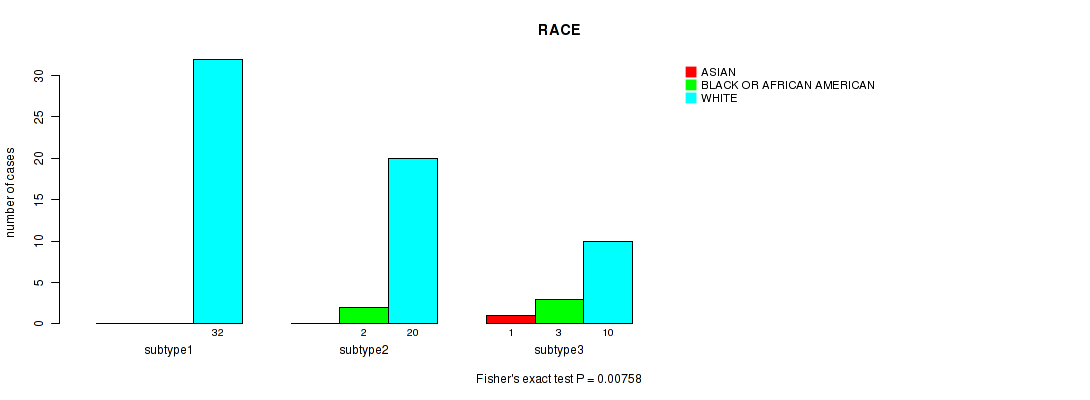
P value = 0.315 (Fisher's exact test), Q value = 1
Table S10. Clustering Approach #1: 'mRNA CNMF subtypes' versus Clinical Feature #11: 'ETHNICITY'
| nPatients | HISPANIC OR LATINO | NOT HISPANIC OR LATINO |
|---|---|---|
| ALL | 7 | 42 |
| subtype1 | 5 | 19 |
| subtype2 | 2 | 11 |
| subtype3 | 0 | 12 |
Figure S9. Get High-res Image Clustering Approach #1: 'mRNA CNMF subtypes' versus Clinical Feature #11: 'ETHNICITY'
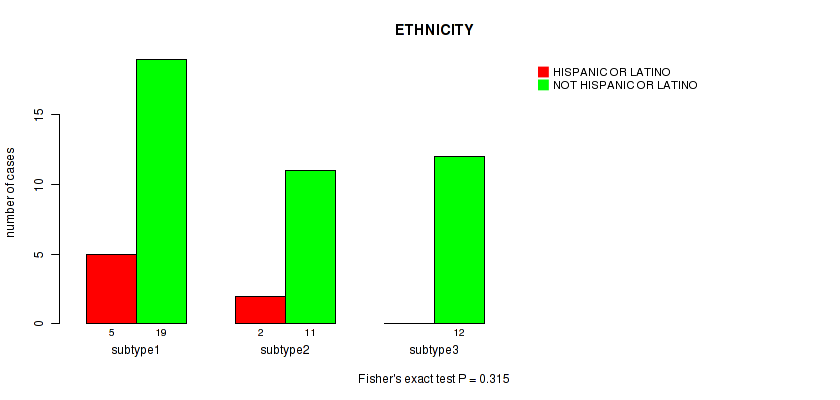
Table S11. Description of clustering approach #2: 'mRNA cHierClus subtypes'
| Cluster Labels | 1 | 2 | 3 | 4 | 5 | 6 | 7 |
|---|---|---|---|---|---|---|---|
| Number of samples | 12 | 12 | 4 | 11 | 13 | 9 | 11 |
P value = 2.96e-06 (logrank test), Q value = 0.00037
Table S12. Clustering Approach #2: 'mRNA cHierClus subtypes' versus Clinical Feature #1: 'Time to Death'
| nPatients | nDeath | Duration Range (Median), Year | |
|---|---|---|---|
| ALL | 61 | 3 | 16.0 - 3074.0 (1137.0) |
| subtype1 | 11 | 0 | 374.0 - 1436.0 (952.0) |
| subtype2 | 10 | 0 | 16.0 - 2746.0 (941.5) |
| subtype3 | 4 | 2 | 51.0 - 1143.0 (527.0) |
| subtype4 | 6 | 1 | 1491.0 - 2839.0 (1961.0) |
| subtype5 | 10 | 0 | 523.0 - 3074.0 (1496.5) |
| subtype6 | 9 | 0 | 43.0 - 1820.0 (873.0) |
| subtype7 | 11 | 0 | 369.0 - 2566.0 (1238.0) |
Figure S10. Get High-res Image Clustering Approach #2: 'mRNA cHierClus subtypes' versus Clinical Feature #1: 'Time to Death'

P value = 0.168 (Kruskal-Wallis (anova)), Q value = 1
Table S13. Clustering Approach #2: 'mRNA cHierClus subtypes' versus Clinical Feature #2: 'AGE'
| nPatients | Mean (Std.Dev) | |
|---|---|---|
| ALL | 71 | 60.5 (12.4) |
| subtype1 | 11 | 63.3 (13.7) |
| subtype2 | 12 | 62.2 (10.8) |
| subtype3 | 4 | 57.2 (10.9) |
| subtype4 | 11 | 56.2 (10.9) |
| subtype5 | 13 | 64.1 (13.5) |
| subtype6 | 9 | 50.7 (10.7) |
| subtype7 | 11 | 65.4 (10.9) |
Figure S11. Get High-res Image Clustering Approach #2: 'mRNA cHierClus subtypes' versus Clinical Feature #2: 'AGE'

P value = 0.00054 (Fisher's exact test), Q value = 0.05
Table S14. Clustering Approach #2: 'mRNA cHierClus subtypes' versus Clinical Feature #3: 'NEOPLASM.DISEASESTAGE'
| nPatients | STAGE I | STAGE II | STAGE III | STAGE IV |
|---|---|---|---|---|
| ALL | 40 | 13 | 14 | 5 |
| subtype1 | 8 | 2 | 2 | 0 |
| subtype2 | 8 | 2 | 2 | 0 |
| subtype3 | 2 | 2 | 0 | 0 |
| subtype4 | 0 | 1 | 6 | 4 |
| subtype5 | 7 | 2 | 3 | 1 |
| subtype6 | 8 | 0 | 1 | 0 |
| subtype7 | 7 | 4 | 0 | 0 |
Figure S12. Get High-res Image Clustering Approach #2: 'mRNA cHierClus subtypes' versus Clinical Feature #3: 'NEOPLASM.DISEASESTAGE'

P value = 0.004 (Fisher's exact test), Q value = 0.34
Table S15. Clustering Approach #2: 'mRNA cHierClus subtypes' versus Clinical Feature #4: 'PATHOLOGY.T.STAGE'
| nPatients | T1 | T2 | T3 |
|---|---|---|---|
| ALL | 41 | 14 | 17 |
| subtype1 | 8 | 2 | 2 |
| subtype2 | 8 | 2 | 2 |
| subtype3 | 2 | 2 | 0 |
| subtype4 | 1 | 2 | 8 |
| subtype5 | 7 | 2 | 4 |
| subtype6 | 8 | 0 | 1 |
| subtype7 | 7 | 4 | 0 |
Figure S13. Get High-res Image Clustering Approach #2: 'mRNA cHierClus subtypes' versus Clinical Feature #4: 'PATHOLOGY.T.STAGE'

P value = 0.1 (Fisher's exact test), Q value = 1
Table S16. Clustering Approach #2: 'mRNA cHierClus subtypes' versus Clinical Feature #5: 'PATHOLOGY.N.STAGE'
| nPatients | 0 | 1 |
|---|---|---|
| ALL | 35 | 3 |
| subtype1 | 6 | 0 |
| subtype2 | 5 | 0 |
| subtype3 | 3 | 0 |
| subtype4 | 5 | 3 |
| subtype5 | 9 | 0 |
| subtype6 | 3 | 0 |
| subtype7 | 4 | 0 |
Figure S14. Get High-res Image Clustering Approach #2: 'mRNA cHierClus subtypes' versus Clinical Feature #5: 'PATHOLOGY.N.STAGE'

P value = 0.0107 (Fisher's exact test), Q value = 0.82
Table S17. Clustering Approach #2: 'mRNA cHierClus subtypes' versus Clinical Feature #6: 'PATHOLOGY.M.STAGE'
| nPatients | M0 | M1 |
|---|---|---|
| ALL | 67 | 5 |
| subtype1 | 12 | 0 |
| subtype2 | 12 | 0 |
| subtype3 | 4 | 0 |
| subtype4 | 7 | 4 |
| subtype5 | 12 | 1 |
| subtype6 | 9 | 0 |
| subtype7 | 11 | 0 |
Figure S15. Get High-res Image Clustering Approach #2: 'mRNA cHierClus subtypes' versus Clinical Feature #6: 'PATHOLOGY.M.STAGE'

P value = 7e-05 (Fisher's exact test), Q value = 0.007
Table S18. Clustering Approach #2: 'mRNA cHierClus subtypes' versus Clinical Feature #7: 'GENDER'
| nPatients | FEMALE | MALE |
|---|---|---|
| ALL | 29 | 43 |
| subtype1 | 0 | 12 |
| subtype2 | 3 | 9 |
| subtype3 | 1 | 3 |
| subtype4 | 6 | 5 |
| subtype5 | 12 | 1 |
| subtype6 | 3 | 6 |
| subtype7 | 4 | 7 |
Figure S16. Get High-res Image Clustering Approach #2: 'mRNA cHierClus subtypes' versus Clinical Feature #7: 'GENDER'

P value = 1e-05 (Fisher's exact test), Q value = 0.0012
Table S19. Clustering Approach #2: 'mRNA cHierClus subtypes' versus Clinical Feature #10: 'RACE'
| nPatients | ASIAN | BLACK OR AFRICAN AMERICAN | WHITE |
|---|---|---|---|
| ALL | 1 | 5 | 62 |
| subtype1 | 0 | 0 | 11 |
| subtype2 | 0 | 1 | 10 |
| subtype3 | 1 | 3 | 0 |
| subtype4 | 0 | 0 | 10 |
| subtype5 | 0 | 0 | 13 |
| subtype6 | 0 | 0 | 8 |
| subtype7 | 0 | 1 | 10 |
Figure S17. Get High-res Image Clustering Approach #2: 'mRNA cHierClus subtypes' versus Clinical Feature #10: 'RACE'

P value = 0.471 (Fisher's exact test), Q value = 1
Table S20. Clustering Approach #2: 'mRNA cHierClus subtypes' versus Clinical Feature #11: 'ETHNICITY'
| nPatients | HISPANIC OR LATINO | NOT HISPANIC OR LATINO |
|---|---|---|
| ALL | 7 | 42 |
| subtype1 | 1 | 7 |
| subtype2 | 0 | 4 |
| subtype3 | 0 | 2 |
| subtype4 | 2 | 6 |
| subtype5 | 3 | 7 |
| subtype6 | 1 | 5 |
| subtype7 | 0 | 11 |
Figure S18. Get High-res Image Clustering Approach #2: 'mRNA cHierClus subtypes' versus Clinical Feature #11: 'ETHNICITY'

Table S21. Description of clustering approach #3: 'Copy Number Ratio CNMF subtypes'
| Cluster Labels | 1 | 2 | 3 |
|---|---|---|---|
| Number of samples | 232 | 131 | 153 |
P value = 0.442 (logrank test), Q value = 1
Table S22. Clustering Approach #3: 'Copy Number Ratio CNMF subtypes' versus Clinical Feature #1: 'Time to Death'
| nPatients | nDeath | Duration Range (Median), Year | |
|---|---|---|---|
| ALL | 371 | 24 | 3.0 - 3668.0 (1280.0) |
| subtype1 | 183 | 9 | 7.0 - 3668.0 (1165.0) |
| subtype2 | 92 | 8 | 16.0 - 3431.0 (1416.5) |
| subtype3 | 96 | 7 | 3.0 - 3343.0 (1285.5) |
Figure S19. Get High-res Image Clustering Approach #3: 'Copy Number Ratio CNMF subtypes' versus Clinical Feature #1: 'Time to Death'

P value = 0.0569 (Kruskal-Wallis (anova)), Q value = 1
Table S23. Clustering Approach #3: 'Copy Number Ratio CNMF subtypes' versus Clinical Feature #2: 'AGE'
| nPatients | Mean (Std.Dev) | |
|---|---|---|
| ALL | 515 | 60.5 (12.1) |
| subtype1 | 232 | 59.9 (12.6) |
| subtype2 | 131 | 59.6 (11.4) |
| subtype3 | 152 | 62.4 (11.8) |
Figure S20. Get High-res Image Clustering Approach #3: 'Copy Number Ratio CNMF subtypes' versus Clinical Feature #2: 'AGE'

P value = 3e-05 (Fisher's exact test), Q value = 0.0031
Table S24. Clustering Approach #3: 'Copy Number Ratio CNMF subtypes' versus Clinical Feature #3: 'NEOPLASM.DISEASESTAGE'
| nPatients | STAGE I | STAGE II | STAGE III | STAGE IV |
|---|---|---|---|---|
| ALL | 253 | 57 | 126 | 80 |
| subtype1 | 136 | 29 | 48 | 19 |
| subtype2 | 64 | 13 | 31 | 23 |
| subtype3 | 53 | 15 | 47 | 38 |
Figure S21. Get High-res Image Clustering Approach #3: 'Copy Number Ratio CNMF subtypes' versus Clinical Feature #3: 'NEOPLASM.DISEASESTAGE'

P value = 3e-05 (Fisher's exact test), Q value = 0.0031
Table S25. Clustering Approach #3: 'Copy Number Ratio CNMF subtypes' versus Clinical Feature #4: 'PATHOLOGY.T.STAGE'
| nPatients | T1 | T2 | T3 | T4 |
|---|---|---|---|---|
| ALL | 258 | 69 | 178 | 11 |
| subtype1 | 136 | 34 | 61 | 1 |
| subtype2 | 65 | 16 | 44 | 6 |
| subtype3 | 57 | 19 | 73 | 4 |
Figure S22. Get High-res Image Clustering Approach #3: 'Copy Number Ratio CNMF subtypes' versus Clinical Feature #4: 'PATHOLOGY.T.STAGE'

P value = 0.0102 (Fisher's exact test), Q value = 0.8
Table S26. Clustering Approach #3: 'Copy Number Ratio CNMF subtypes' versus Clinical Feature #5: 'PATHOLOGY.N.STAGE'
| nPatients | 0 | 1 |
|---|---|---|
| ALL | 231 | 18 |
| subtype1 | 107 | 3 |
| subtype2 | 58 | 4 |
| subtype3 | 66 | 11 |
Figure S23. Get High-res Image Clustering Approach #3: 'Copy Number Ratio CNMF subtypes' versus Clinical Feature #5: 'PATHOLOGY.N.STAGE'

P value = 0.00043 (Fisher's exact test), Q value = 0.04
Table S27. Clustering Approach #3: 'Copy Number Ratio CNMF subtypes' versus Clinical Feature #6: 'PATHOLOGY.M.STAGE'
| nPatients | M0 | M1 | MX |
|---|---|---|---|
| ALL | 417 | 78 | 19 |
| subtype1 | 202 | 19 | 10 |
| subtype2 | 105 | 21 | 4 |
| subtype3 | 110 | 38 | 5 |
Figure S24. Get High-res Image Clustering Approach #3: 'Copy Number Ratio CNMF subtypes' versus Clinical Feature #6: 'PATHOLOGY.M.STAGE'

P value = 0.00438 (Fisher's exact test), Q value = 0.36
Table S28. Clustering Approach #3: 'Copy Number Ratio CNMF subtypes' versus Clinical Feature #7: 'GENDER'
| nPatients | FEMALE | MALE |
|---|---|---|
| ALL | 186 | 330 |
| subtype1 | 92 | 140 |
| subtype2 | 55 | 76 |
| subtype3 | 39 | 114 |
Figure S25. Get High-res Image Clustering Approach #3: 'Copy Number Ratio CNMF subtypes' versus Clinical Feature #7: 'GENDER'
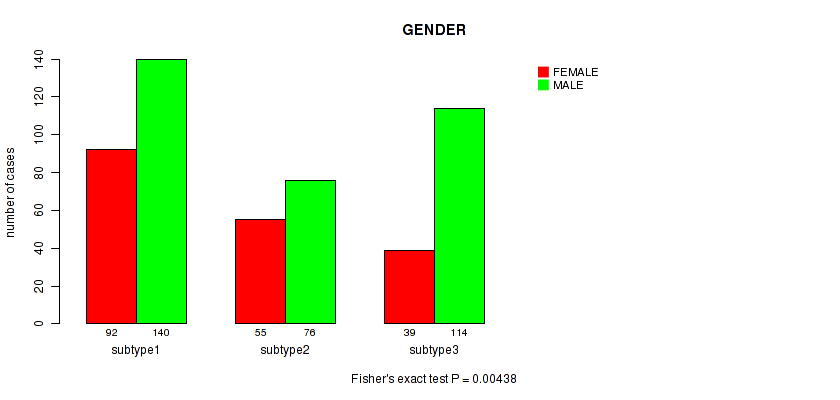
P value = 0.414 (Kruskal-Wallis (anova)), Q value = 1
Table S29. Clustering Approach #3: 'Copy Number Ratio CNMF subtypes' versus Clinical Feature #8: 'KARNOFSKY.PERFORMANCE.SCORE'
| nPatients | Mean (Std.Dev) | |
|---|---|---|
| ALL | 41 | 88.5 (21.6) |
| subtype1 | 16 | 92.5 (8.6) |
| subtype2 | 8 | 95.0 (7.6) |
| subtype3 | 17 | 81.8 (31.5) |
Figure S26. Get High-res Image Clustering Approach #3: 'Copy Number Ratio CNMF subtypes' versus Clinical Feature #8: 'KARNOFSKY.PERFORMANCE.SCORE'
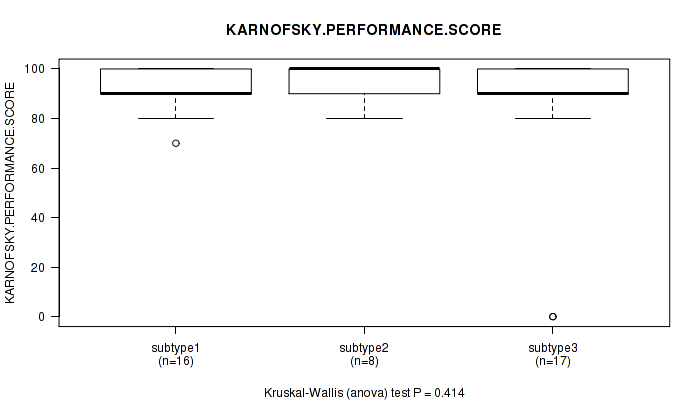
P value = 0.506 (Kruskal-Wallis (anova)), Q value = 1
Table S30. Clustering Approach #3: 'Copy Number Ratio CNMF subtypes' versus Clinical Feature #9: 'NUMBERPACKYEARSSMOKED'
| nPatients | Mean (Std.Dev) | |
|---|---|---|
| ALL | 12 | 27.2 (16.2) |
| subtype1 | 4 | 30.8 (17.2) |
| subtype2 | 3 | 33.3 (20.8) |
| subtype3 | 5 | 20.6 (13.7) |
Figure S27. Get High-res Image Clustering Approach #3: 'Copy Number Ratio CNMF subtypes' versus Clinical Feature #9: 'NUMBERPACKYEARSSMOKED'
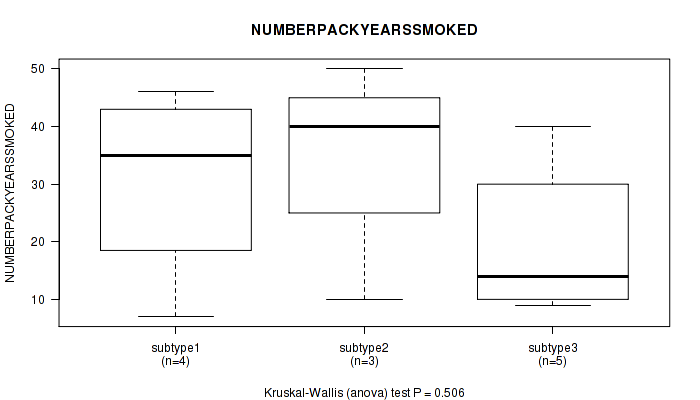
P value = 0.0125 (Fisher's exact test), Q value = 0.94
Table S31. Clustering Approach #3: 'Copy Number Ratio CNMF subtypes' versus Clinical Feature #10: 'RACE'
| nPatients | ASIAN | BLACK OR AFRICAN AMERICAN | WHITE |
|---|---|---|---|
| ALL | 8 | 44 | 457 |
| subtype1 | 2 | 15 | 212 |
| subtype2 | 4 | 20 | 106 |
| subtype3 | 2 | 9 | 139 |
Figure S28. Get High-res Image Clustering Approach #3: 'Copy Number Ratio CNMF subtypes' versus Clinical Feature #10: 'RACE'
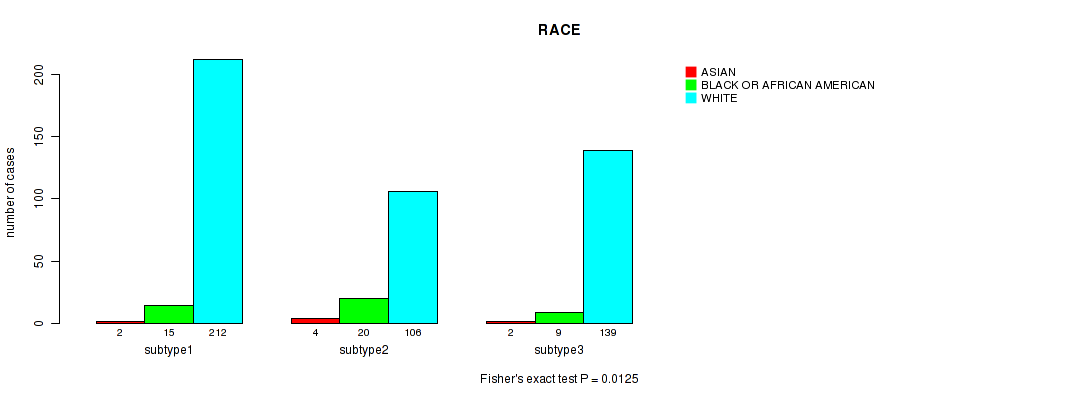
P value = 0.732 (Fisher's exact test), Q value = 1
Table S32. Clustering Approach #3: 'Copy Number Ratio CNMF subtypes' versus Clinical Feature #11: 'ETHNICITY'
| nPatients | HISPANIC OR LATINO | NOT HISPANIC OR LATINO |
|---|---|---|
| ALL | 26 | 338 |
| subtype1 | 13 | 145 |
| subtype2 | 7 | 93 |
| subtype3 | 6 | 100 |
Figure S29. Get High-res Image Clustering Approach #3: 'Copy Number Ratio CNMF subtypes' versus Clinical Feature #11: 'ETHNICITY'
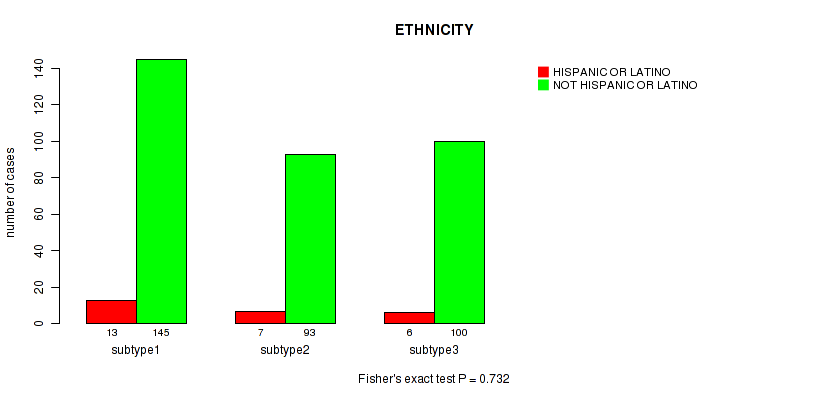
Table S33. Description of clustering approach #4: 'METHLYATION CNMF'
| Cluster Labels | 1 | 2 | 3 |
|---|---|---|---|
| Number of samples | 122 | 76 | 109 |
P value = 0.582 (logrank test), Q value = 1
Table S34. Clustering Approach #4: 'METHLYATION CNMF' versus Clinical Feature #1: 'Time to Death'
| nPatients | nDeath | Duration Range (Median), Year | |
|---|---|---|---|
| ALL | 217 | 11 | 3.0 - 3668.0 (1082.0) |
| subtype1 | 105 | 4 | 3.0 - 3668.0 (1124.0) |
| subtype2 | 53 | 3 | 15.0 - 3343.0 (932.0) |
| subtype3 | 59 | 4 | 7.0 - 2741.0 (1280.0) |
Figure S30. Get High-res Image Clustering Approach #4: 'METHLYATION CNMF' versus Clinical Feature #1: 'Time to Death'

P value = 0.00693 (Kruskal-Wallis (anova)), Q value = 0.56
Table S35. Clustering Approach #4: 'METHLYATION CNMF' versus Clinical Feature #2: 'AGE'
| nPatients | Mean (Std.Dev) | |
|---|---|---|
| ALL | 307 | 61.4 (11.8) |
| subtype1 | 122 | 59.1 (12.6) |
| subtype2 | 76 | 62.1 (11.5) |
| subtype3 | 109 | 63.6 (10.7) |
Figure S31. Get High-res Image Clustering Approach #4: 'METHLYATION CNMF' versus Clinical Feature #2: 'AGE'

P value = 1e-05 (Fisher's exact test), Q value = 0.0012
Table S36. Clustering Approach #4: 'METHLYATION CNMF' versus Clinical Feature #3: 'NEOPLASM.DISEASESTAGE'
| nPatients | STAGE I | STAGE II | STAGE III | STAGE IV |
|---|---|---|---|---|
| ALL | 146 | 31 | 74 | 56 |
| subtype1 | 82 | 17 | 13 | 10 |
| subtype2 | 42 | 2 | 20 | 12 |
| subtype3 | 22 | 12 | 41 | 34 |
Figure S32. Get High-res Image Clustering Approach #4: 'METHLYATION CNMF' versus Clinical Feature #3: 'NEOPLASM.DISEASESTAGE'

P value = 1e-05 (Fisher's exact test), Q value = 0.0012
Table S37. Clustering Approach #4: 'METHLYATION CNMF' versus Clinical Feature #4: 'PATHOLOGY.T.STAGE'
| nPatients | T1 | T2 | T3 | T4 |
|---|---|---|---|---|
| ALL | 149 | 41 | 109 | 8 |
| subtype1 | 82 | 21 | 19 | 0 |
| subtype2 | 44 | 3 | 25 | 4 |
| subtype3 | 23 | 17 | 65 | 4 |
Figure S33. Get High-res Image Clustering Approach #4: 'METHLYATION CNMF' versus Clinical Feature #4: 'PATHOLOGY.T.STAGE'

P value = 0.25 (Fisher's exact test), Q value = 1
Table S38. Clustering Approach #4: 'METHLYATION CNMF' versus Clinical Feature #5: 'PATHOLOGY.N.STAGE'
| nPatients | 0 | 1 |
|---|---|---|
| ALL | 130 | 9 |
| subtype1 | 51 | 1 |
| subtype2 | 31 | 3 |
| subtype3 | 48 | 5 |
Figure S34. Get High-res Image Clustering Approach #4: 'METHLYATION CNMF' versus Clinical Feature #5: 'PATHOLOGY.N.STAGE'

P value = 0.00014 (Fisher's exact test), Q value = 0.014
Table S39. Clustering Approach #4: 'METHLYATION CNMF' versus Clinical Feature #6: 'PATHOLOGY.M.STAGE'
| nPatients | M0 | M1 | MX |
|---|---|---|---|
| ALL | 233 | 53 | 19 |
| subtype1 | 102 | 10 | 9 |
| subtype2 | 58 | 10 | 7 |
| subtype3 | 73 | 33 | 3 |
Figure S35. Get High-res Image Clustering Approach #4: 'METHLYATION CNMF' versus Clinical Feature #6: 'PATHOLOGY.M.STAGE'

P value = 3e-05 (Fisher's exact test), Q value = 0.0031
Table S40. Clustering Approach #4: 'METHLYATION CNMF' versus Clinical Feature #7: 'GENDER'
| nPatients | FEMALE | MALE |
|---|---|---|
| ALL | 111 | 196 |
| subtype1 | 59 | 63 |
| subtype2 | 31 | 45 |
| subtype3 | 21 | 88 |
Figure S36. Get High-res Image Clustering Approach #4: 'METHLYATION CNMF' versus Clinical Feature #7: 'GENDER'
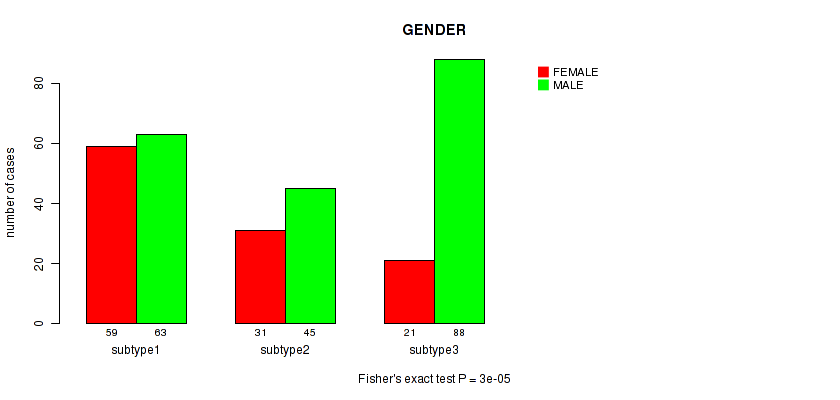
P value = 0.367 (Kruskal-Wallis (anova)), Q value = 1
Table S41. Clustering Approach #4: 'METHLYATION CNMF' versus Clinical Feature #8: 'KARNOFSKY.PERFORMANCE.SCORE'
| nPatients | Mean (Std.Dev) | |
|---|---|---|
| ALL | 33 | 92.1 (7.8) |
| subtype1 | 18 | 91.7 (7.9) |
| subtype2 | 8 | 95.0 (7.6) |
| subtype3 | 7 | 90.0 (8.2) |
Figure S37. Get High-res Image Clustering Approach #4: 'METHLYATION CNMF' versus Clinical Feature #8: 'KARNOFSKY.PERFORMANCE.SCORE'
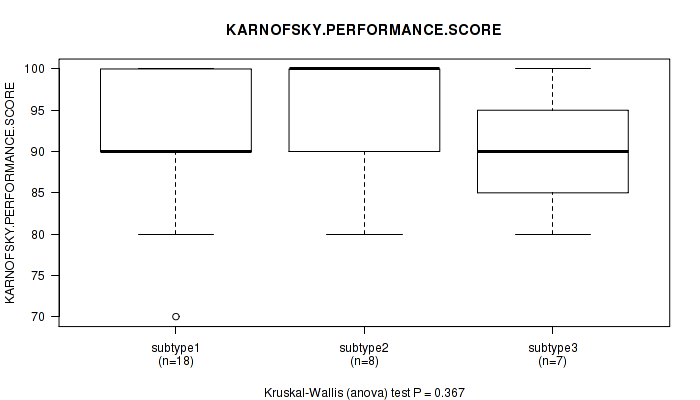
P value = 0.672 (Kruskal-Wallis (anova)), Q value = 1
Table S42. Clustering Approach #4: 'METHLYATION CNMF' versus Clinical Feature #9: 'NUMBERPACKYEARSSMOKED'
| nPatients | Mean (Std.Dev) | |
|---|---|---|
| ALL | 12 | 27.2 (16.2) |
| subtype1 | 3 | 28.3 (18.6) |
| subtype2 | 6 | 31.2 (18.0) |
| subtype3 | 3 | 18.0 (10.6) |
Figure S38. Get High-res Image Clustering Approach #4: 'METHLYATION CNMF' versus Clinical Feature #9: 'NUMBERPACKYEARSSMOKED'
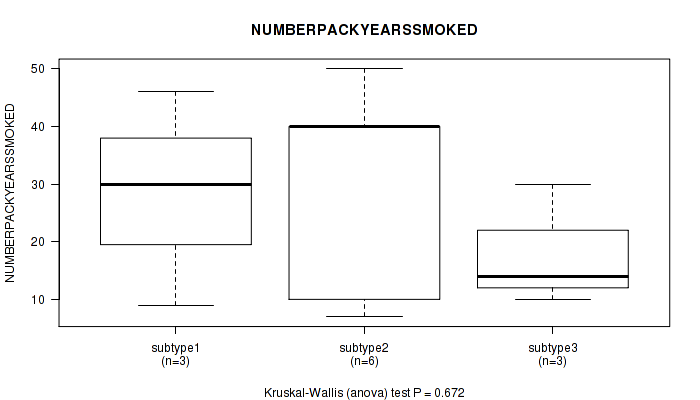
P value = 0.026 (Fisher's exact test), Q value = 1
Table S43. Clustering Approach #4: 'METHLYATION CNMF' versus Clinical Feature #10: 'RACE'
| nPatients | ASIAN | BLACK OR AFRICAN AMERICAN | WHITE |
|---|---|---|---|
| ALL | 1 | 37 | 266 |
| subtype1 | 0 | 13 | 109 |
| subtype2 | 0 | 16 | 60 |
| subtype3 | 1 | 8 | 97 |
Figure S39. Get High-res Image Clustering Approach #4: 'METHLYATION CNMF' versus Clinical Feature #10: 'RACE'
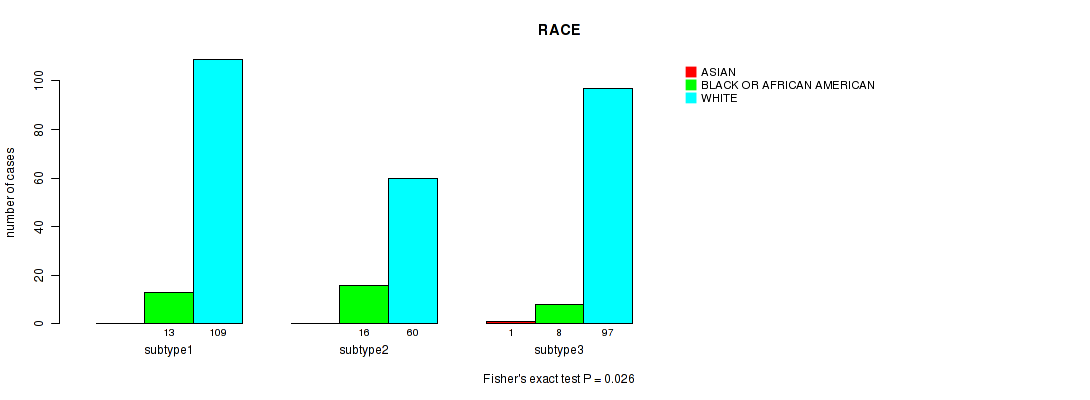
P value = 1 (Fisher's exact test), Q value = 1
Table S44. Clustering Approach #4: 'METHLYATION CNMF' versus Clinical Feature #11: 'ETHNICITY'
| nPatients | HISPANIC OR LATINO | NOT HISPANIC OR LATINO |
|---|---|---|
| ALL | 10 | 248 |
| subtype1 | 4 | 93 |
| subtype2 | 2 | 62 |
| subtype3 | 4 | 93 |
Figure S40. Get High-res Image Clustering Approach #4: 'METHLYATION CNMF' versus Clinical Feature #11: 'ETHNICITY'
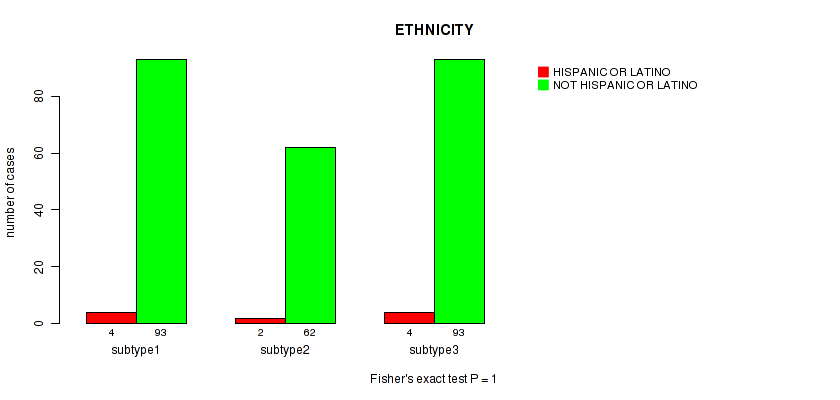
Table S45. Description of clustering approach #5: 'RPPA CNMF subtypes'
| Cluster Labels | 1 | 2 | 3 | 4 | 5 | 6 |
|---|---|---|---|---|---|---|
| Number of samples | 108 | 62 | 77 | 81 | 81 | 45 |
P value = 0.0393 (logrank test), Q value = 1
Table S46. Clustering Approach #5: 'RPPA CNMF subtypes' versus Clinical Feature #1: 'Time to Death'
| nPatients | nDeath | Duration Range (Median), Year | |
|---|---|---|---|
| ALL | 319 | 23 | 7.0 - 3668.0 (1373.0) |
| subtype1 | 84 | 4 | 7.0 - 3668.0 (1503.0) |
| subtype2 | 24 | 5 | 16.0 - 3117.0 (1408.5) |
| subtype3 | 57 | 4 | 7.0 - 3431.0 (1106.0) |
| subtype4 | 59 | 5 | 15.0 - 3037.0 (1133.0) |
| subtype5 | 55 | 5 | 18.0 - 3222.0 (1459.0) |
| subtype6 | 40 | 0 | 29.0 - 3146.0 (1149.0) |
Figure S41. Get High-res Image Clustering Approach #5: 'RPPA CNMF subtypes' versus Clinical Feature #1: 'Time to Death'

P value = 0.173 (Kruskal-Wallis (anova)), Q value = 1
Table S47. Clustering Approach #5: 'RPPA CNMF subtypes' versus Clinical Feature #2: 'AGE'
| nPatients | Mean (Std.Dev) | |
|---|---|---|
| ALL | 453 | 60.4 (12.3) |
| subtype1 | 107 | 61.8 (10.9) |
| subtype2 | 62 | 62.1 (11.9) |
| subtype3 | 77 | 61.6 (12.4) |
| subtype4 | 81 | 60.2 (11.7) |
| subtype5 | 81 | 57.7 (12.3) |
| subtype6 | 45 | 58.0 (16.0) |
Figure S42. Get High-res Image Clustering Approach #5: 'RPPA CNMF subtypes' versus Clinical Feature #2: 'AGE'

P value = 1e-05 (Fisher's exact test), Q value = 0.0012
Table S48. Clustering Approach #5: 'RPPA CNMF subtypes' versus Clinical Feature #3: 'NEOPLASM.DISEASESTAGE'
| nPatients | STAGE I | STAGE II | STAGE III | STAGE IV |
|---|---|---|---|---|
| ALL | 219 | 44 | 115 | 76 |
| subtype1 | 58 | 12 | 24 | 14 |
| subtype2 | 8 | 4 | 26 | 24 |
| subtype3 | 33 | 10 | 23 | 11 |
| subtype4 | 47 | 7 | 18 | 9 |
| subtype5 | 38 | 9 | 16 | 18 |
| subtype6 | 35 | 2 | 8 | 0 |
Figure S43. Get High-res Image Clustering Approach #5: 'RPPA CNMF subtypes' versus Clinical Feature #3: 'NEOPLASM.DISEASESTAGE'

P value = 1e-05 (Fisher's exact test), Q value = 0.0012
Table S49. Clustering Approach #5: 'RPPA CNMF subtypes' versus Clinical Feature #4: 'PATHOLOGY.T.STAGE'
| nPatients | T1 | T2 | T3 | T4 |
|---|---|---|---|---|
| ALL | 224 | 54 | 165 | 11 |
| subtype1 | 58 | 16 | 33 | 1 |
| subtype2 | 9 | 9 | 40 | 4 |
| subtype3 | 35 | 10 | 32 | 0 |
| subtype4 | 48 | 7 | 25 | 1 |
| subtype5 | 39 | 10 | 27 | 5 |
| subtype6 | 35 | 2 | 8 | 0 |
Figure S44. Get High-res Image Clustering Approach #5: 'RPPA CNMF subtypes' versus Clinical Feature #4: 'PATHOLOGY.T.STAGE'

P value = 0.013 (Fisher's exact test), Q value = 0.95
Table S50. Clustering Approach #5: 'RPPA CNMF subtypes' versus Clinical Feature #5: 'PATHOLOGY.N.STAGE'
| nPatients | 0 | 1 |
|---|---|---|
| ALL | 208 | 16 |
| subtype1 | 51 | 1 |
| subtype2 | 26 | 8 |
| subtype3 | 40 | 2 |
| subtype4 | 38 | 3 |
| subtype5 | 39 | 2 |
| subtype6 | 14 | 0 |
Figure S45. Get High-res Image Clustering Approach #5: 'RPPA CNMF subtypes' versus Clinical Feature #5: 'PATHOLOGY.N.STAGE'

P value = 1e-05 (Fisher's exact test), Q value = 0.0012
Table S51. Clustering Approach #5: 'RPPA CNMF subtypes' versus Clinical Feature #6: 'PATHOLOGY.M.STAGE'
| nPatients | M0 | M1 |
|---|---|---|
| ALL | 379 | 75 |
| subtype1 | 94 | 14 |
| subtype2 | 38 | 24 |
| subtype3 | 66 | 11 |
| subtype4 | 72 | 9 |
| subtype5 | 64 | 17 |
| subtype6 | 45 | 0 |
Figure S46. Get High-res Image Clustering Approach #5: 'RPPA CNMF subtypes' versus Clinical Feature #6: 'PATHOLOGY.M.STAGE'

P value = 0.102 (Fisher's exact test), Q value = 1
Table S52. Clustering Approach #5: 'RPPA CNMF subtypes' versus Clinical Feature #7: 'GENDER'
| nPatients | FEMALE | MALE |
|---|---|---|
| ALL | 151 | 303 |
| subtype1 | 46 | 62 |
| subtype2 | 16 | 46 |
| subtype3 | 23 | 54 |
| subtype4 | 22 | 59 |
| subtype5 | 25 | 56 |
| subtype6 | 19 | 26 |
Figure S47. Get High-res Image Clustering Approach #5: 'RPPA CNMF subtypes' versus Clinical Feature #7: 'GENDER'

P value = 0.109 (Kruskal-Wallis (anova)), Q value = 1
Table S53. Clustering Approach #5: 'RPPA CNMF subtypes' versus Clinical Feature #8: 'KARNOFSKY.PERFORMANCE.SCORE'
| nPatients | Mean (Std.Dev) | |
|---|---|---|
| ALL | 34 | 93.5 (7.7) |
| subtype1 | 7 | 91.4 (6.9) |
| subtype2 | 3 | 93.3 (11.5) |
| subtype3 | 10 | 90.0 (9.4) |
| subtype4 | 3 | 100.0 (0.0) |
| subtype5 | 7 | 94.3 (5.3) |
| subtype6 | 4 | 100.0 (0.0) |
Figure S48. Get High-res Image Clustering Approach #5: 'RPPA CNMF subtypes' versus Clinical Feature #8: 'KARNOFSKY.PERFORMANCE.SCORE'

P value = 0.112 (Fisher's exact test), Q value = 1
Table S54. Clustering Approach #5: 'RPPA CNMF subtypes' versus Clinical Feature #10: 'RACE'
| nPatients | ASIAN | BLACK OR AFRICAN AMERICAN | WHITE |
|---|---|---|---|
| ALL | 8 | 20 | 420 |
| subtype1 | 0 | 5 | 101 |
| subtype2 | 2 | 0 | 60 |
| subtype3 | 1 | 1 | 71 |
| subtype4 | 1 | 7 | 73 |
| subtype5 | 3 | 5 | 73 |
| subtype6 | 1 | 2 | 42 |
Figure S49. Get High-res Image Clustering Approach #5: 'RPPA CNMF subtypes' versus Clinical Feature #10: 'RACE'

P value = 0.352 (Fisher's exact test), Q value = 1
Table S55. Clustering Approach #5: 'RPPA CNMF subtypes' versus Clinical Feature #11: 'ETHNICITY'
| nPatients | HISPANIC OR LATINO | NOT HISPANIC OR LATINO |
|---|---|---|
| ALL | 19 | 295 |
| subtype1 | 6 | 72 |
| subtype2 | 3 | 45 |
| subtype3 | 5 | 53 |
| subtype4 | 1 | 45 |
| subtype5 | 1 | 55 |
| subtype6 | 3 | 25 |
Figure S50. Get High-res Image Clustering Approach #5: 'RPPA CNMF subtypes' versus Clinical Feature #11: 'ETHNICITY'

Table S56. Description of clustering approach #6: 'RPPA cHierClus subtypes'
| Cluster Labels | 1 | 2 | 3 |
|---|---|---|---|
| Number of samples | 122 | 200 | 132 |
P value = 2.35e-05 (logrank test), Q value = 0.0025
Table S57. Clustering Approach #6: 'RPPA cHierClus subtypes' versus Clinical Feature #1: 'Time to Death'
| nPatients | nDeath | Duration Range (Median), Year | |
|---|---|---|---|
| ALL | 319 | 23 | 7.0 - 3668.0 (1373.0) |
| subtype1 | 93 | 3 | 11.0 - 3668.0 (1487.0) |
| subtype2 | 160 | 7 | 16.0 - 3222.0 (1378.0) |
| subtype3 | 66 | 13 | 7.0 - 3431.0 (1137.5) |
Figure S51. Get High-res Image Clustering Approach #6: 'RPPA cHierClus subtypes' versus Clinical Feature #1: 'Time to Death'

P value = 0.111 (Kruskal-Wallis (anova)), Q value = 1
Table S58. Clustering Approach #6: 'RPPA cHierClus subtypes' versus Clinical Feature #2: 'AGE'
| nPatients | Mean (Std.Dev) | |
|---|---|---|
| ALL | 453 | 60.4 (12.3) |
| subtype1 | 121 | 60.9 (12.0) |
| subtype2 | 200 | 59.0 (13.0) |
| subtype3 | 132 | 62.0 (11.2) |
Figure S52. Get High-res Image Clustering Approach #6: 'RPPA cHierClus subtypes' versus Clinical Feature #2: 'AGE'

P value = 1e-05 (Fisher's exact test), Q value = 0.0012
Table S59. Clustering Approach #6: 'RPPA cHierClus subtypes' versus Clinical Feature #3: 'NEOPLASM.DISEASESTAGE'
| nPatients | STAGE I | STAGE II | STAGE III | STAGE IV |
|---|---|---|---|---|
| ALL | 219 | 44 | 115 | 76 |
| subtype1 | 54 | 15 | 39 | 14 |
| subtype2 | 130 | 16 | 37 | 17 |
| subtype3 | 35 | 13 | 39 | 45 |
Figure S53. Get High-res Image Clustering Approach #6: 'RPPA cHierClus subtypes' versus Clinical Feature #3: 'NEOPLASM.DISEASESTAGE'

P value = 1e-05 (Fisher's exact test), Q value = 0.0012
Table S60. Clustering Approach #6: 'RPPA cHierClus subtypes' versus Clinical Feature #4: 'PATHOLOGY.T.STAGE'
| nPatients | T1 | T2 | T3 | T4 |
|---|---|---|---|---|
| ALL | 224 | 54 | 165 | 11 |
| subtype1 | 55 | 17 | 49 | 1 |
| subtype2 | 132 | 19 | 48 | 1 |
| subtype3 | 37 | 18 | 68 | 9 |
Figure S54. Get High-res Image Clustering Approach #6: 'RPPA cHierClus subtypes' versus Clinical Feature #4: 'PATHOLOGY.T.STAGE'

P value = 0.0539 (Fisher's exact test), Q value = 1
Table S61. Clustering Approach #6: 'RPPA cHierClus subtypes' versus Clinical Feature #5: 'PATHOLOGY.N.STAGE'
| nPatients | 0 | 1 |
|---|---|---|
| ALL | 208 | 16 |
| subtype1 | 63 | 2 |
| subtype2 | 78 | 4 |
| subtype3 | 67 | 10 |
Figure S55. Get High-res Image Clustering Approach #6: 'RPPA cHierClus subtypes' versus Clinical Feature #5: 'PATHOLOGY.N.STAGE'

P value = 1e-05 (Fisher's exact test), Q value = 0.0012
Table S62. Clustering Approach #6: 'RPPA cHierClus subtypes' versus Clinical Feature #6: 'PATHOLOGY.M.STAGE'
| nPatients | M0 | M1 |
|---|---|---|
| ALL | 379 | 75 |
| subtype1 | 109 | 13 |
| subtype2 | 182 | 18 |
| subtype3 | 88 | 44 |
Figure S56. Get High-res Image Clustering Approach #6: 'RPPA cHierClus subtypes' versus Clinical Feature #6: 'PATHOLOGY.M.STAGE'

P value = 0.104 (Fisher's exact test), Q value = 1
Table S63. Clustering Approach #6: 'RPPA cHierClus subtypes' versus Clinical Feature #7: 'GENDER'
| nPatients | FEMALE | MALE |
|---|---|---|
| ALL | 151 | 303 |
| subtype1 | 34 | 88 |
| subtype2 | 77 | 123 |
| subtype3 | 40 | 92 |
Figure S57. Get High-res Image Clustering Approach #6: 'RPPA cHierClus subtypes' versus Clinical Feature #7: 'GENDER'

P value = 0.0648 (Kruskal-Wallis (anova)), Q value = 1
Table S64. Clustering Approach #6: 'RPPA cHierClus subtypes' versus Clinical Feature #8: 'KARNOFSKY.PERFORMANCE.SCORE'
| nPatients | Mean (Std.Dev) | |
|---|---|---|
| ALL | 34 | 93.5 (7.7) |
| subtype1 | 8 | 90.0 (9.3) |
| subtype2 | 16 | 96.9 (4.8) |
| subtype3 | 10 | 91.0 (8.8) |
Figure S58. Get High-res Image Clustering Approach #6: 'RPPA cHierClus subtypes' versus Clinical Feature #8: 'KARNOFSKY.PERFORMANCE.SCORE'
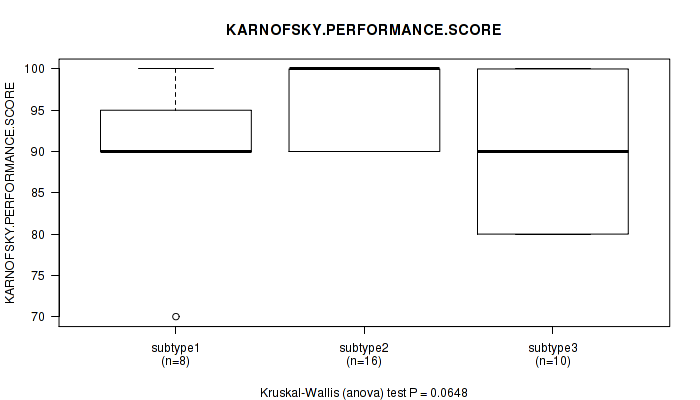
P value = 0.849 (Fisher's exact test), Q value = 1
Table S65. Clustering Approach #6: 'RPPA cHierClus subtypes' versus Clinical Feature #10: 'RACE'
| nPatients | ASIAN | BLACK OR AFRICAN AMERICAN | WHITE |
|---|---|---|---|
| ALL | 8 | 20 | 420 |
| subtype1 | 1 | 4 | 115 |
| subtype2 | 4 | 9 | 184 |
| subtype3 | 3 | 7 | 121 |
Figure S59. Get High-res Image Clustering Approach #6: 'RPPA cHierClus subtypes' versus Clinical Feature #10: 'RACE'
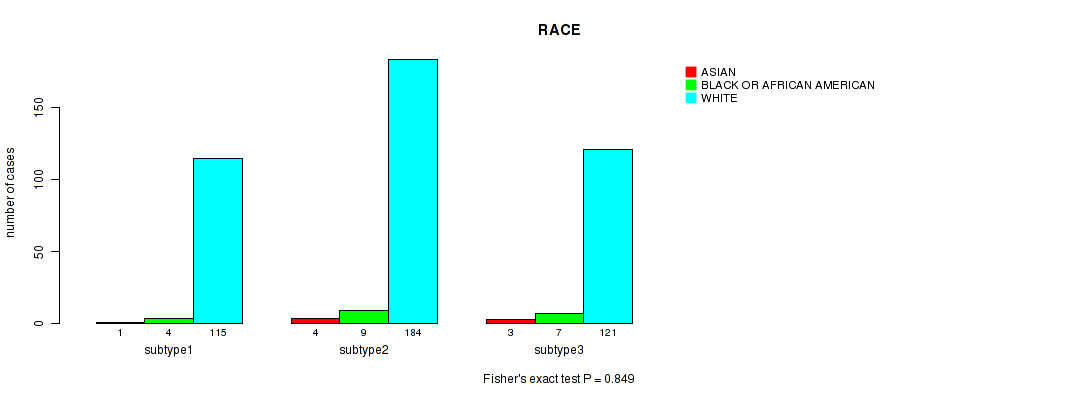
P value = 0.0664 (Fisher's exact test), Q value = 1
Table S66. Clustering Approach #6: 'RPPA cHierClus subtypes' versus Clinical Feature #11: 'ETHNICITY'
| nPatients | HISPANIC OR LATINO | NOT HISPANIC OR LATINO |
|---|---|---|
| ALL | 19 | 295 |
| subtype1 | 9 | 82 |
| subtype2 | 8 | 117 |
| subtype3 | 2 | 96 |
Figure S60. Get High-res Image Clustering Approach #6: 'RPPA cHierClus subtypes' versus Clinical Feature #11: 'ETHNICITY'
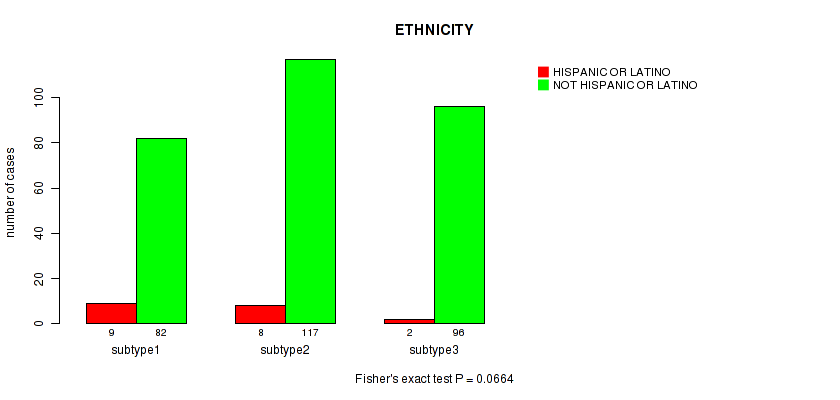
Table S67. Description of clustering approach #7: 'RNAseq CNMF subtypes'
| Cluster Labels | 1 | 2 | 3 |
|---|---|---|---|
| Number of samples | 107 | 218 | 194 |
P value = 0.0137 (logrank test), Q value = 0.99
Table S68. Clustering Approach #7: 'RNAseq CNMF subtypes' versus Clinical Feature #1: 'Time to Death'
| nPatients | nDeath | Duration Range (Median), Year | |
|---|---|---|---|
| ALL | 373 | 23 | 3.0 - 3668.0 (1307.0) |
| subtype1 | 84 | 8 | 13.0 - 3431.0 (1311.0) |
| subtype2 | 174 | 4 | 3.0 - 3668.0 (1299.0) |
| subtype3 | 115 | 11 | 7.0 - 3343.0 (1280.0) |
Figure S61. Get High-res Image Clustering Approach #7: 'RNAseq CNMF subtypes' versus Clinical Feature #1: 'Time to Death'

P value = 0.16 (Kruskal-Wallis (anova)), Q value = 1
Table S69. Clustering Approach #7: 'RNAseq CNMF subtypes' versus Clinical Feature #2: 'AGE'
| nPatients | Mean (Std.Dev) | |
|---|---|---|
| ALL | 518 | 60.7 (12.1) |
| subtype1 | 107 | 58.7 (12.8) |
| subtype2 | 217 | 61.4 (12.1) |
| subtype3 | 194 | 61.0 (11.7) |
Figure S62. Get High-res Image Clustering Approach #7: 'RNAseq CNMF subtypes' versus Clinical Feature #2: 'AGE'

P value = 1e-05 (Fisher's exact test), Q value = 0.0012
Table S70. Clustering Approach #7: 'RNAseq CNMF subtypes' versus Clinical Feature #3: 'NEOPLASM.DISEASESTAGE'
| nPatients | STAGE I | STAGE II | STAGE III | STAGE IV |
|---|---|---|---|---|
| ALL | 256 | 57 | 125 | 81 |
| subtype1 | 66 | 12 | 19 | 10 |
| subtype2 | 129 | 23 | 41 | 25 |
| subtype3 | 61 | 22 | 65 | 46 |
Figure S63. Get High-res Image Clustering Approach #7: 'RNAseq CNMF subtypes' versus Clinical Feature #3: 'NEOPLASM.DISEASESTAGE'

P value = 1e-05 (Fisher's exact test), Q value = 0.0012
Table S71. Clustering Approach #7: 'RNAseq CNMF subtypes' versus Clinical Feature #4: 'PATHOLOGY.T.STAGE'
| nPatients | T1 | T2 | T3 | T4 |
|---|---|---|---|---|
| ALL | 262 | 69 | 177 | 11 |
| subtype1 | 67 | 13 | 24 | 3 |
| subtype2 | 129 | 27 | 60 | 2 |
| subtype3 | 66 | 29 | 93 | 6 |
Figure S64. Get High-res Image Clustering Approach #7: 'RNAseq CNMF subtypes' versus Clinical Feature #4: 'PATHOLOGY.T.STAGE'

P value = 0.0125 (Fisher's exact test), Q value = 0.94
Table S72. Clustering Approach #7: 'RNAseq CNMF subtypes' versus Clinical Feature #5: 'PATHOLOGY.N.STAGE'
| nPatients | 0 | 1 |
|---|---|---|
| ALL | 237 | 17 |
| subtype1 | 48 | 3 |
| subtype2 | 100 | 2 |
| subtype3 | 89 | 12 |
Figure S65. Get High-res Image Clustering Approach #7: 'RNAseq CNMF subtypes' versus Clinical Feature #5: 'PATHOLOGY.N.STAGE'

P value = 0.00169 (Fisher's exact test), Q value = 0.15
Table S73. Clustering Approach #7: 'RNAseq CNMF subtypes' versus Clinical Feature #6: 'PATHOLOGY.M.STAGE'
| nPatients | M0 | M1 | MX |
|---|---|---|---|
| ALL | 421 | 79 | 18 |
| subtype1 | 94 | 9 | 4 |
| subtype2 | 185 | 24 | 8 |
| subtype3 | 142 | 46 | 6 |
Figure S66. Get High-res Image Clustering Approach #7: 'RNAseq CNMF subtypes' versus Clinical Feature #6: 'PATHOLOGY.M.STAGE'

P value = 2e-05 (Fisher's exact test), Q value = 0.0021
Table S74. Clustering Approach #7: 'RNAseq CNMF subtypes' versus Clinical Feature #7: 'GENDER'
| nPatients | FEMALE | MALE |
|---|---|---|
| ALL | 184 | 335 |
| subtype1 | 36 | 71 |
| subtype2 | 101 | 117 |
| subtype3 | 47 | 147 |
Figure S67. Get High-res Image Clustering Approach #7: 'RNAseq CNMF subtypes' versus Clinical Feature #7: 'GENDER'

P value = 0.554 (Kruskal-Wallis (anova)), Q value = 1
Table S75. Clustering Approach #7: 'RNAseq CNMF subtypes' versus Clinical Feature #8: 'KARNOFSKY.PERFORMANCE.SCORE'
| nPatients | Mean (Std.Dev) | |
|---|---|---|
| ALL | 40 | 90.8 (16.5) |
| subtype1 | 8 | 95.0 (7.6) |
| subtype2 | 18 | 91.7 (7.9) |
| subtype3 | 14 | 87.1 (26.1) |
Figure S68. Get High-res Image Clustering Approach #7: 'RNAseq CNMF subtypes' versus Clinical Feature #8: 'KARNOFSKY.PERFORMANCE.SCORE'

P value = 0.541 (Kruskal-Wallis (anova)), Q value = 1
Table S76. Clustering Approach #7: 'RNAseq CNMF subtypes' versus Clinical Feature #9: 'NUMBERPACKYEARSSMOKED'
| nPatients | Mean (Std.Dev) | |
|---|---|---|
| ALL | 10 | 30.2 (16.1) |
| subtype1 | 2 | 40.0 (14.1) |
| subtype2 | 3 | 31.7 (19.9) |
| subtype3 | 5 | 25.4 (16.0) |
Figure S69. Get High-res Image Clustering Approach #7: 'RNAseq CNMF subtypes' versus Clinical Feature #9: 'NUMBERPACKYEARSSMOKED'

P value = 0.033 (Fisher's exact test), Q value = 1
Table S77. Clustering Approach #7: 'RNAseq CNMF subtypes' versus Clinical Feature #10: 'RACE'
| nPatients | ASIAN | BLACK OR AFRICAN AMERICAN | WHITE |
|---|---|---|---|
| ALL | 8 | 42 | 462 |
| subtype1 | 4 | 15 | 87 |
| subtype2 | 2 | 14 | 199 |
| subtype3 | 2 | 13 | 176 |
Figure S70. Get High-res Image Clustering Approach #7: 'RNAseq CNMF subtypes' versus Clinical Feature #10: 'RACE'
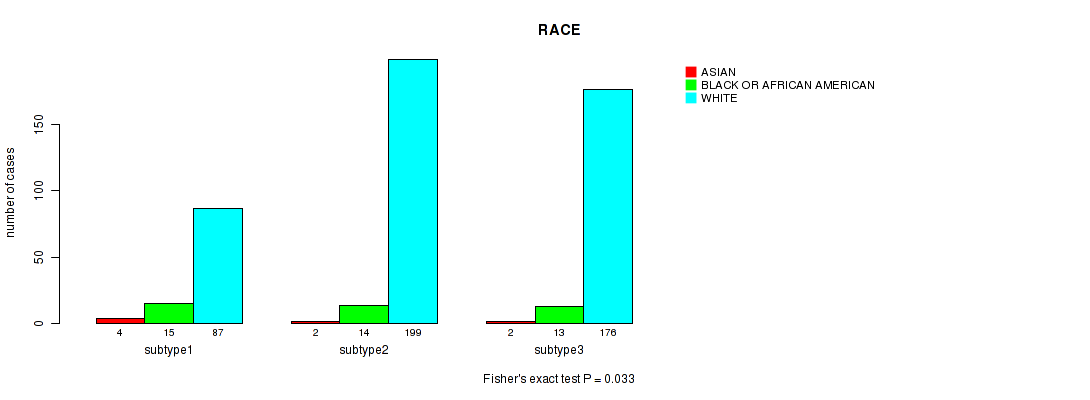
P value = 0.122 (Fisher's exact test), Q value = 1
Table S78. Clustering Approach #7: 'RNAseq CNMF subtypes' versus Clinical Feature #11: 'ETHNICITY'
| nPatients | HISPANIC OR LATINO | NOT HISPANIC OR LATINO |
|---|---|---|
| ALL | 26 | 342 |
| subtype1 | 3 | 75 |
| subtype2 | 16 | 137 |
| subtype3 | 7 | 130 |
Figure S71. Get High-res Image Clustering Approach #7: 'RNAseq CNMF subtypes' versus Clinical Feature #11: 'ETHNICITY'
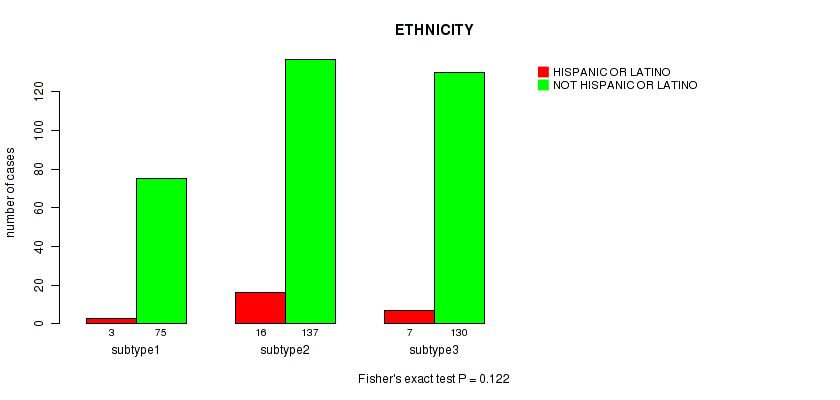
Table S79. Description of clustering approach #8: 'RNAseq cHierClus subtypes'
| Cluster Labels | 1 | 2 | 3 |
|---|---|---|---|
| Number of samples | 162 | 232 | 125 |
P value = 0.019 (logrank test), Q value = 1
Table S80. Clustering Approach #8: 'RNAseq cHierClus subtypes' versus Clinical Feature #1: 'Time to Death'
| nPatients | nDeath | Duration Range (Median), Year | |
|---|---|---|---|
| ALL | 373 | 23 | 3.0 - 3668.0 (1307.0) |
| subtype1 | 126 | 7 | 13.0 - 3431.0 (1154.0) |
| subtype2 | 183 | 7 | 3.0 - 3668.0 (1291.0) |
| subtype3 | 64 | 9 | 7.0 - 3343.0 (1425.5) |
Figure S72. Get High-res Image Clustering Approach #8: 'RNAseq cHierClus subtypes' versus Clinical Feature #1: 'Time to Death'

P value = 0.162 (Kruskal-Wallis (anova)), Q value = 1
Table S81. Clustering Approach #8: 'RNAseq cHierClus subtypes' versus Clinical Feature #2: 'AGE'
| nPatients | Mean (Std.Dev) | |
|---|---|---|
| ALL | 518 | 60.7 (12.1) |
| subtype1 | 162 | 59.3 (13.1) |
| subtype2 | 231 | 60.9 (11.9) |
| subtype3 | 125 | 62.0 (11.2) |
Figure S73. Get High-res Image Clustering Approach #8: 'RNAseq cHierClus subtypes' versus Clinical Feature #2: 'AGE'

P value = 1e-05 (Fisher's exact test), Q value = 0.0012
Table S82. Clustering Approach #8: 'RNAseq cHierClus subtypes' versus Clinical Feature #3: 'NEOPLASM.DISEASESTAGE'
| nPatients | STAGE I | STAGE II | STAGE III | STAGE IV |
|---|---|---|---|---|
| ALL | 256 | 57 | 125 | 81 |
| subtype1 | 92 | 19 | 35 | 16 |
| subtype2 | 131 | 26 | 44 | 31 |
| subtype3 | 33 | 12 | 46 | 34 |
Figure S74. Get High-res Image Clustering Approach #8: 'RNAseq cHierClus subtypes' versus Clinical Feature #3: 'NEOPLASM.DISEASESTAGE'

P value = 1e-05 (Fisher's exact test), Q value = 0.0012
Table S83. Clustering Approach #8: 'RNAseq cHierClus subtypes' versus Clinical Feature #4: 'PATHOLOGY.T.STAGE'
| nPatients | T1 | T2 | T3 | T4 |
|---|---|---|---|---|
| ALL | 262 | 69 | 177 | 11 |
| subtype1 | 96 | 22 | 42 | 2 |
| subtype2 | 132 | 33 | 65 | 2 |
| subtype3 | 34 | 14 | 70 | 7 |
Figure S75. Get High-res Image Clustering Approach #8: 'RNAseq cHierClus subtypes' versus Clinical Feature #4: 'PATHOLOGY.T.STAGE'

P value = 0.00114 (Fisher's exact test), Q value = 0.1
Table S84. Clustering Approach #8: 'RNAseq cHierClus subtypes' versus Clinical Feature #5: 'PATHOLOGY.N.STAGE'
| nPatients | 0 | 1 |
|---|---|---|
| ALL | 237 | 17 |
| subtype1 | 72 | 6 |
| subtype2 | 103 | 1 |
| subtype3 | 62 | 10 |
Figure S76. Get High-res Image Clustering Approach #8: 'RNAseq cHierClus subtypes' versus Clinical Feature #5: 'PATHOLOGY.N.STAGE'

P value = 0.00187 (Fisher's exact test), Q value = 0.16
Table S85. Clustering Approach #8: 'RNAseq cHierClus subtypes' versus Clinical Feature #6: 'PATHOLOGY.M.STAGE'
| nPatients | M0 | M1 | MX |
|---|---|---|---|
| ALL | 421 | 79 | 18 |
| subtype1 | 138 | 16 | 8 |
| subtype2 | 193 | 30 | 8 |
| subtype3 | 90 | 33 | 2 |
Figure S77. Get High-res Image Clustering Approach #8: 'RNAseq cHierClus subtypes' versus Clinical Feature #6: 'PATHOLOGY.M.STAGE'

P value = 0.00012 (Fisher's exact test), Q value = 0.012
Table S86. Clustering Approach #8: 'RNAseq cHierClus subtypes' versus Clinical Feature #7: 'GENDER'
| nPatients | FEMALE | MALE |
|---|---|---|
| ALL | 184 | 335 |
| subtype1 | 50 | 112 |
| subtype2 | 104 | 128 |
| subtype3 | 30 | 95 |
Figure S78. Get High-res Image Clustering Approach #8: 'RNAseq cHierClus subtypes' versus Clinical Feature #7: 'GENDER'

P value = 0.198 (Kruskal-Wallis (anova)), Q value = 1
Table S87. Clustering Approach #8: 'RNAseq cHierClus subtypes' versus Clinical Feature #8: 'KARNOFSKY.PERFORMANCE.SCORE'
| nPatients | Mean (Std.Dev) | |
|---|---|---|
| ALL | 40 | 90.8 (16.5) |
| subtype1 | 13 | 94.6 (9.7) |
| subtype2 | 18 | 92.8 (5.7) |
| subtype3 | 9 | 81.1 (31.4) |
Figure S79. Get High-res Image Clustering Approach #8: 'RNAseq cHierClus subtypes' versus Clinical Feature #8: 'KARNOFSKY.PERFORMANCE.SCORE'

P value = 0.88 (Kruskal-Wallis (anova)), Q value = 1
Table S88. Clustering Approach #8: 'RNAseq cHierClus subtypes' versus Clinical Feature #9: 'NUMBERPACKYEARSSMOKED'
| nPatients | Mean (Std.Dev) | |
|---|---|---|
| ALL | 10 | 30.2 (16.1) |
| subtype1 | 5 | 31.4 (16.0) |
| subtype2 | 3 | 31.7 (19.9) |
| subtype3 | 2 | 25.0 (21.2) |
Figure S80. Get High-res Image Clustering Approach #8: 'RNAseq cHierClus subtypes' versus Clinical Feature #9: 'NUMBERPACKYEARSSMOKED'
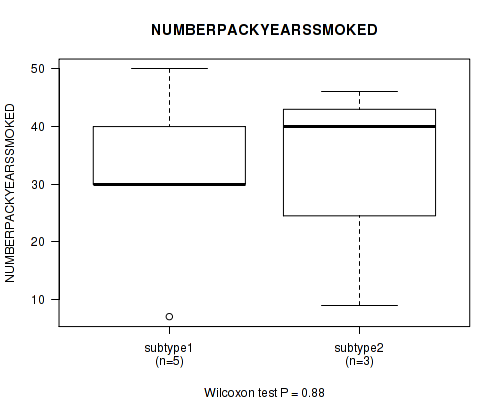
P value = 0.0333 (Fisher's exact test), Q value = 1
Table S89. Clustering Approach #8: 'RNAseq cHierClus subtypes' versus Clinical Feature #10: 'RACE'
| nPatients | ASIAN | BLACK OR AFRICAN AMERICAN | WHITE |
|---|---|---|---|
| ALL | 8 | 42 | 462 |
| subtype1 | 4 | 21 | 136 |
| subtype2 | 2 | 16 | 208 |
| subtype3 | 2 | 5 | 118 |
Figure S81. Get High-res Image Clustering Approach #8: 'RNAseq cHierClus subtypes' versus Clinical Feature #10: 'RACE'
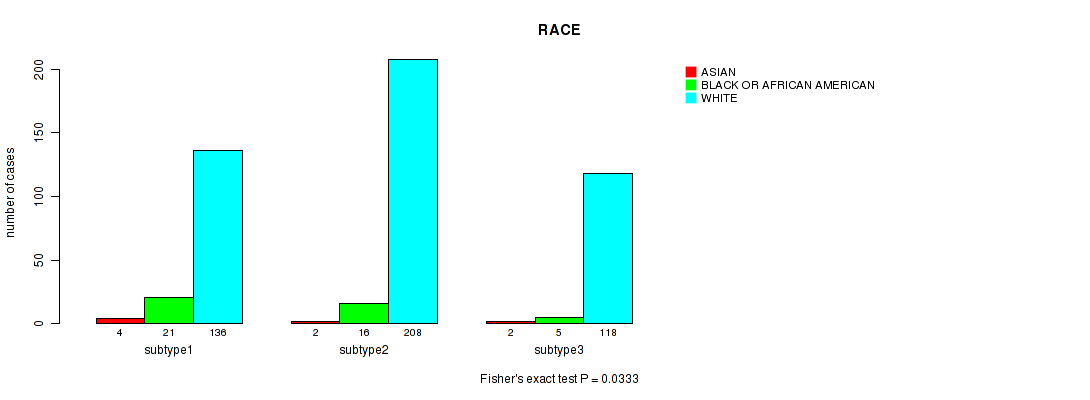
P value = 0.756 (Fisher's exact test), Q value = 1
Table S90. Clustering Approach #8: 'RNAseq cHierClus subtypes' versus Clinical Feature #11: 'ETHNICITY'
| nPatients | HISPANIC OR LATINO | NOT HISPANIC OR LATINO |
|---|---|---|
| ALL | 26 | 342 |
| subtype1 | 8 | 113 |
| subtype2 | 13 | 144 |
| subtype3 | 5 | 85 |
Figure S82. Get High-res Image Clustering Approach #8: 'RNAseq cHierClus subtypes' versus Clinical Feature #11: 'ETHNICITY'
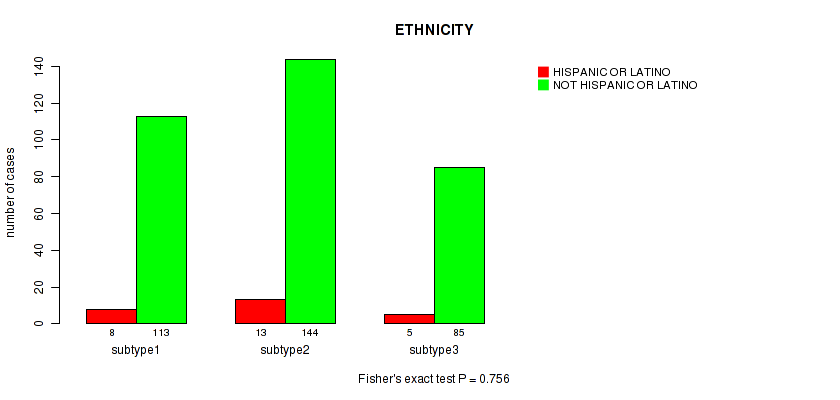
Table S91. Description of clustering approach #9: 'MIRSEQ CNMF'
| Cluster Labels | 1 | 2 | 3 |
|---|---|---|---|
| Number of samples | 121 | 201 | 182 |
P value = 0.042 (logrank test), Q value = 1
Table S92. Clustering Approach #9: 'MIRSEQ CNMF' versus Clinical Feature #1: 'Time to Death'
| nPatients | nDeath | Duration Range (Median), Year | |
|---|---|---|---|
| ALL | 360 | 23 | 3.0 - 3668.0 (1307.5) |
| subtype1 | 93 | 4 | 3.0 - 3431.0 (1459.0) |
| subtype2 | 158 | 7 | 7.0 - 3668.0 (1318.0) |
| subtype3 | 109 | 12 | 7.0 - 2859.0 (1143.0) |
Figure S83. Get High-res Image Clustering Approach #9: 'MIRSEQ CNMF' versus Clinical Feature #1: 'Time to Death'

P value = 0.0281 (Kruskal-Wallis (anova)), Q value = 1
Table S93. Clustering Approach #9: 'MIRSEQ CNMF' versus Clinical Feature #2: 'AGE'
| nPatients | Mean (Std.Dev) | |
|---|---|---|
| ALL | 504 | 60.6 (12.1) |
| subtype1 | 121 | 58.2 (12.2) |
| subtype2 | 201 | 62.2 (12.2) |
| subtype3 | 182 | 60.3 (11.6) |
Figure S84. Get High-res Image Clustering Approach #9: 'MIRSEQ CNMF' versus Clinical Feature #2: 'AGE'

P value = 0.00038 (Fisher's exact test), Q value = 0.036
Table S94. Clustering Approach #9: 'MIRSEQ CNMF' versus Clinical Feature #3: 'NEOPLASM.DISEASESTAGE'
| nPatients | STAGE I | STAGE II | STAGE III | STAGE IV |
|---|---|---|---|---|
| ALL | 244 | 55 | 125 | 80 |
| subtype1 | 72 | 11 | 28 | 10 |
| subtype2 | 108 | 20 | 45 | 28 |
| subtype3 | 64 | 24 | 52 | 42 |
Figure S85. Get High-res Image Clustering Approach #9: 'MIRSEQ CNMF' versus Clinical Feature #3: 'NEOPLASM.DISEASESTAGE'

P value = 0.00078 (Fisher's exact test), Q value = 0.072
Table S95. Clustering Approach #9: 'MIRSEQ CNMF' versus Clinical Feature #4: 'PATHOLOGY.T.STAGE'
| nPatients | T1 | T2 | T3 | T4 |
|---|---|---|---|---|
| ALL | 249 | 67 | 177 | 11 |
| subtype1 | 73 | 11 | 33 | 4 |
| subtype2 | 109 | 26 | 64 | 2 |
| subtype3 | 67 | 30 | 80 | 5 |
Figure S86. Get High-res Image Clustering Approach #9: 'MIRSEQ CNMF' versus Clinical Feature #4: 'PATHOLOGY.T.STAGE'

P value = 0.0119 (Fisher's exact test), Q value = 0.91
Table S96. Clustering Approach #9: 'MIRSEQ CNMF' versus Clinical Feature #5: 'PATHOLOGY.N.STAGE'
| nPatients | 0 | 1 |
|---|---|---|
| ALL | 225 | 18 |
| subtype1 | 55 | 3 |
| subtype2 | 87 | 2 |
| subtype3 | 83 | 13 |
Figure S87. Get High-res Image Clustering Approach #9: 'MIRSEQ CNMF' versus Clinical Feature #5: 'PATHOLOGY.N.STAGE'

P value = 0.00335 (Fisher's exact test), Q value = 0.28
Table S97. Clustering Approach #9: 'MIRSEQ CNMF' versus Clinical Feature #6: 'PATHOLOGY.M.STAGE'
| nPatients | M0 | M1 | MX |
|---|---|---|---|
| ALL | 405 | 78 | 19 |
| subtype1 | 104 | 9 | 6 |
| subtype2 | 168 | 27 | 6 |
| subtype3 | 133 | 42 | 7 |
Figure S88. Get High-res Image Clustering Approach #9: 'MIRSEQ CNMF' versus Clinical Feature #6: 'PATHOLOGY.M.STAGE'
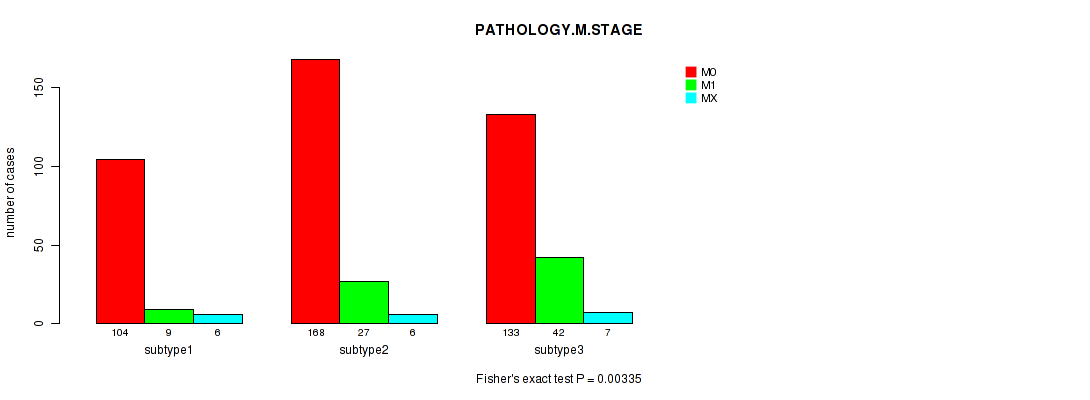
P value = 0.00247 (Fisher's exact test), Q value = 0.21
Table S98. Clustering Approach #9: 'MIRSEQ CNMF' versus Clinical Feature #7: 'GENDER'
| nPatients | FEMALE | MALE |
|---|---|---|
| ALL | 178 | 326 |
| subtype1 | 43 | 78 |
| subtype2 | 87 | 114 |
| subtype3 | 48 | 134 |
Figure S89. Get High-res Image Clustering Approach #9: 'MIRSEQ CNMF' versus Clinical Feature #7: 'GENDER'
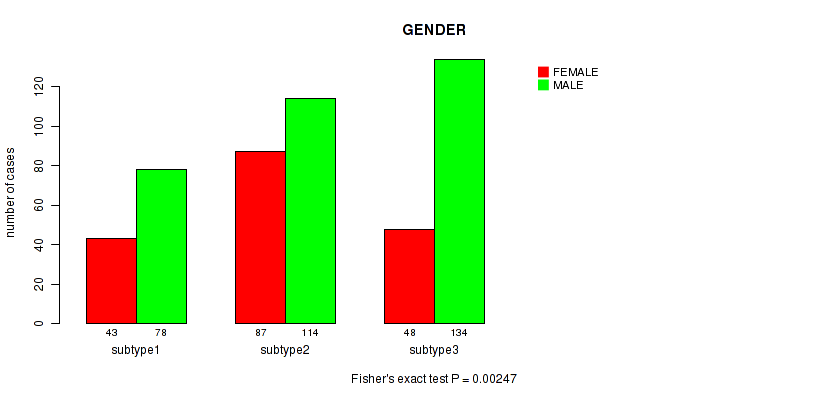
P value = 0.777 (Kruskal-Wallis (anova)), Q value = 1
Table S99. Clustering Approach #9: 'MIRSEQ CNMF' versus Clinical Feature #8: 'KARNOFSKY.PERFORMANCE.SCORE'
| nPatients | Mean (Std.Dev) | |
|---|---|---|
| ALL | 41 | 88.5 (21.6) |
| subtype1 | 11 | 93.6 (8.1) |
| subtype2 | 19 | 92.1 (7.9) |
| subtype3 | 11 | 77.3 (38.8) |
Figure S90. Get High-res Image Clustering Approach #9: 'MIRSEQ CNMF' versus Clinical Feature #8: 'KARNOFSKY.PERFORMANCE.SCORE'
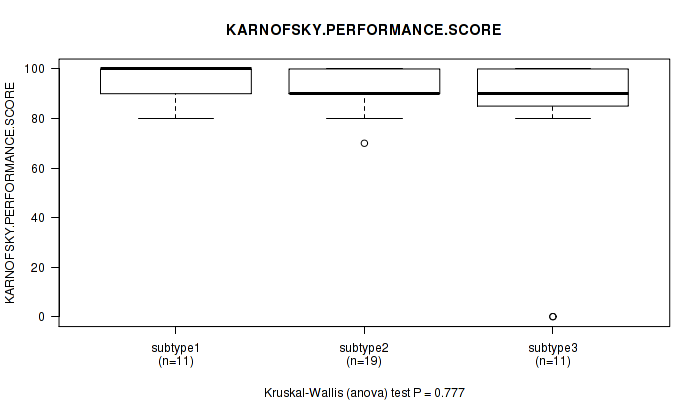
P value = 0.591 (Kruskal-Wallis (anova)), Q value = 1
Table S100. Clustering Approach #9: 'MIRSEQ CNMF' versus Clinical Feature #9: 'NUMBERPACKYEARSSMOKED'
| nPatients | Mean (Std.Dev) | |
|---|---|---|
| ALL | 12 | 27.2 (16.2) |
| subtype1 | 4 | 18.2 (14.7) |
| subtype2 | 2 | 43.0 (4.2) |
| subtype3 | 6 | 27.8 (16.7) |
Figure S91. Get High-res Image Clustering Approach #9: 'MIRSEQ CNMF' versus Clinical Feature #9: 'NUMBERPACKYEARSSMOKED'
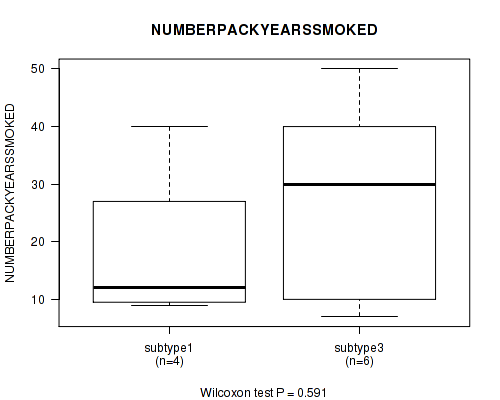
P value = 0.299 (Fisher's exact test), Q value = 1
Table S101. Clustering Approach #9: 'MIRSEQ CNMF' versus Clinical Feature #10: 'RACE'
| nPatients | ASIAN | BLACK OR AFRICAN AMERICAN | WHITE |
|---|---|---|---|
| ALL | 8 | 44 | 445 |
| subtype1 | 1 | 15 | 104 |
| subtype2 | 3 | 12 | 182 |
| subtype3 | 4 | 17 | 159 |
Figure S92. Get High-res Image Clustering Approach #9: 'MIRSEQ CNMF' versus Clinical Feature #10: 'RACE'
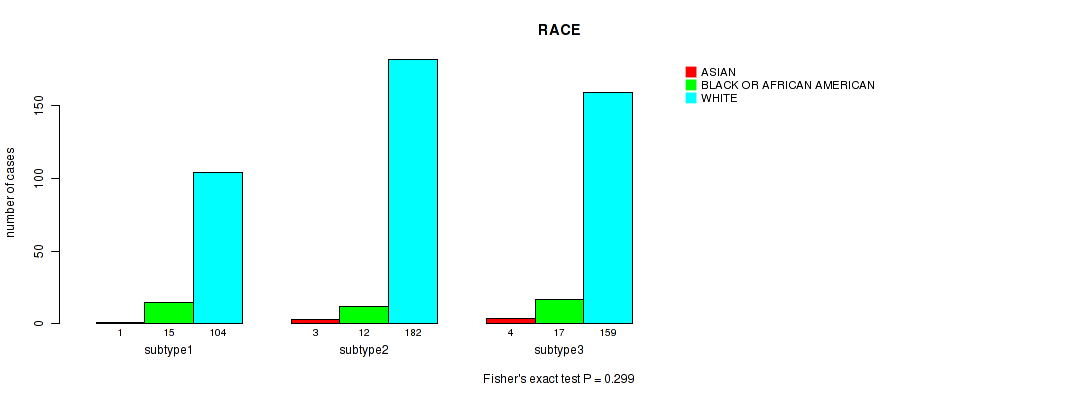
P value = 0.224 (Fisher's exact test), Q value = 1
Table S102. Clustering Approach #9: 'MIRSEQ CNMF' versus Clinical Feature #11: 'ETHNICITY'
| nPatients | HISPANIC OR LATINO | NOT HISPANIC OR LATINO |
|---|---|---|
| ALL | 24 | 333 |
| subtype1 | 2 | 78 |
| subtype2 | 12 | 130 |
| subtype3 | 10 | 125 |
Figure S93. Get High-res Image Clustering Approach #9: 'MIRSEQ CNMF' versus Clinical Feature #11: 'ETHNICITY'
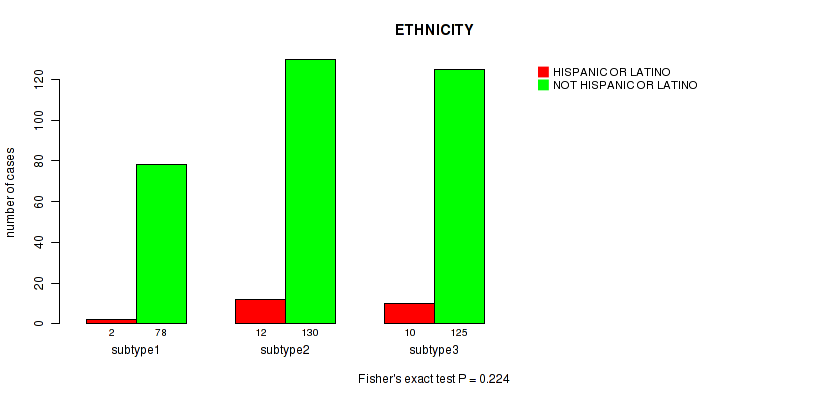
Table S103. Description of clustering approach #10: 'MIRSEQ CHIERARCHICAL'
| Cluster Labels | 1 | 2 | 3 | 4 |
|---|---|---|---|---|
| Number of samples | 142 | 134 | 191 | 37 |
P value = 0.104 (logrank test), Q value = 1
Table S104. Clustering Approach #10: 'MIRSEQ CHIERARCHICAL' versus Clinical Feature #1: 'Time to Death'
| nPatients | nDeath | Duration Range (Median), Year | |
|---|---|---|---|
| ALL | 360 | 23 | 3.0 - 3668.0 (1307.5) |
| subtype1 | 99 | 7 | 15.0 - 3431.0 (1385.0) |
| subtype2 | 95 | 10 | 7.0 - 2859.0 (1107.0) |
| subtype3 | 152 | 5 | 3.0 - 3668.0 (1372.0) |
| subtype4 | 14 | 1 | 665.0 - 2718.0 (1740.5) |
Figure S94. Get High-res Image Clustering Approach #10: 'MIRSEQ CHIERARCHICAL' versus Clinical Feature #1: 'Time to Death'

P value = 0.0704 (Kruskal-Wallis (anova)), Q value = 1
Table S105. Clustering Approach #10: 'MIRSEQ CHIERARCHICAL' versus Clinical Feature #2: 'AGE'
| nPatients | Mean (Std.Dev) | |
|---|---|---|
| ALL | 504 | 60.6 (12.1) |
| subtype1 | 142 | 59.1 (12.5) |
| subtype2 | 134 | 59.5 (11.9) |
| subtype3 | 191 | 61.7 (11.9) |
| subtype4 | 37 | 64.2 (11.0) |
Figure S95. Get High-res Image Clustering Approach #10: 'MIRSEQ CHIERARCHICAL' versus Clinical Feature #2: 'AGE'

P value = 2e-05 (Fisher's exact test), Q value = 0.0021
Table S106. Clustering Approach #10: 'MIRSEQ CHIERARCHICAL' versus Clinical Feature #3: 'NEOPLASM.DISEASESTAGE'
| nPatients | STAGE I | STAGE II | STAGE III | STAGE IV |
|---|---|---|---|---|
| ALL | 244 | 55 | 125 | 80 |
| subtype1 | 79 | 10 | 36 | 17 |
| subtype2 | 49 | 17 | 35 | 33 |
| subtype3 | 107 | 24 | 42 | 18 |
| subtype4 | 9 | 4 | 12 | 12 |
Figure S96. Get High-res Image Clustering Approach #10: 'MIRSEQ CHIERARCHICAL' versus Clinical Feature #3: 'NEOPLASM.DISEASESTAGE'

P value = 8e-05 (Fisher's exact test), Q value = 0.0079
Table S107. Clustering Approach #10: 'MIRSEQ CHIERARCHICAL' versus Clinical Feature #4: 'PATHOLOGY.T.STAGE'
| nPatients | T1 | T2 | T3 | T4 |
|---|---|---|---|---|
| ALL | 249 | 67 | 177 | 11 |
| subtype1 | 80 | 11 | 46 | 5 |
| subtype2 | 51 | 23 | 57 | 3 |
| subtype3 | 109 | 28 | 53 | 1 |
| subtype4 | 9 | 5 | 21 | 2 |
Figure S97. Get High-res Image Clustering Approach #10: 'MIRSEQ CHIERARCHICAL' versus Clinical Feature #4: 'PATHOLOGY.T.STAGE'

P value = 0.0194 (Fisher's exact test), Q value = 1
Table S108. Clustering Approach #10: 'MIRSEQ CHIERARCHICAL' versus Clinical Feature #5: 'PATHOLOGY.N.STAGE'
| nPatients | 0 | 1 |
|---|---|---|
| ALL | 225 | 18 |
| subtype1 | 60 | 8 |
| subtype2 | 65 | 8 |
| subtype3 | 84 | 1 |
| subtype4 | 16 | 1 |
Figure S98. Get High-res Image Clustering Approach #10: 'MIRSEQ CHIERARCHICAL' versus Clinical Feature #5: 'PATHOLOGY.N.STAGE'

P value = 0.00027 (Fisher's exact test), Q value = 0.026
Table S109. Clustering Approach #10: 'MIRSEQ CHIERARCHICAL' versus Clinical Feature #6: 'PATHOLOGY.M.STAGE'
| nPatients | M0 | M1 | MX |
|---|---|---|---|
| ALL | 405 | 78 | 19 |
| subtype1 | 118 | 15 | 7 |
| subtype2 | 98 | 32 | 4 |
| subtype3 | 165 | 18 | 8 |
| subtype4 | 24 | 13 | 0 |
Figure S99. Get High-res Image Clustering Approach #10: 'MIRSEQ CHIERARCHICAL' versus Clinical Feature #6: 'PATHOLOGY.M.STAGE'

P value = 0.00137 (Fisher's exact test), Q value = 0.12
Table S110. Clustering Approach #10: 'MIRSEQ CHIERARCHICAL' versus Clinical Feature #7: 'GENDER'
| nPatients | FEMALE | MALE |
|---|---|---|
| ALL | 178 | 326 |
| subtype1 | 54 | 88 |
| subtype2 | 36 | 98 |
| subtype3 | 82 | 109 |
| subtype4 | 6 | 31 |
Figure S100. Get High-res Image Clustering Approach #10: 'MIRSEQ CHIERARCHICAL' versus Clinical Feature #7: 'GENDER'
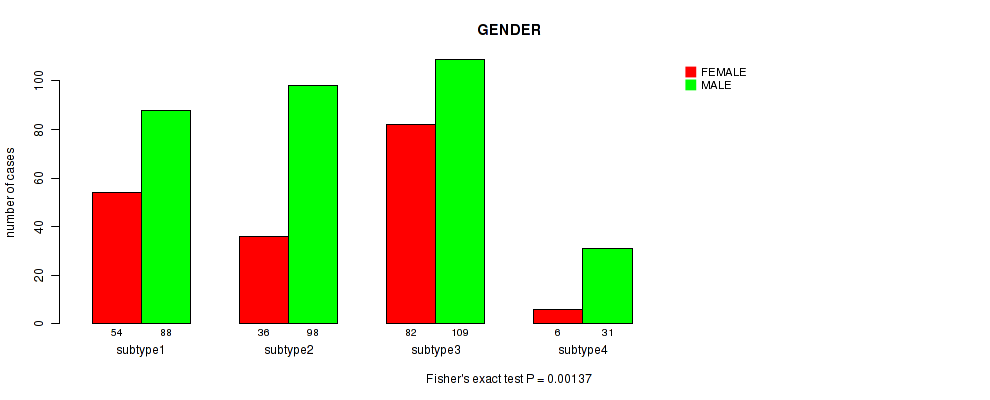
P value = 0.156 (Kruskal-Wallis (anova)), Q value = 1
Table S111. Clustering Approach #10: 'MIRSEQ CHIERARCHICAL' versus Clinical Feature #8: 'KARNOFSKY.PERFORMANCE.SCORE'
| nPatients | Mean (Std.Dev) | |
|---|---|---|
| ALL | 41 | 88.5 (21.6) |
| subtype1 | 14 | 87.9 (26.1) |
| subtype2 | 10 | 79.0 (29.6) |
| subtype3 | 16 | 94.4 (5.1) |
| subtype4 | 1 | 100.0 (NA) |
Figure S101. Get High-res Image Clustering Approach #10: 'MIRSEQ CHIERARCHICAL' versus Clinical Feature #8: 'KARNOFSKY.PERFORMANCE.SCORE'
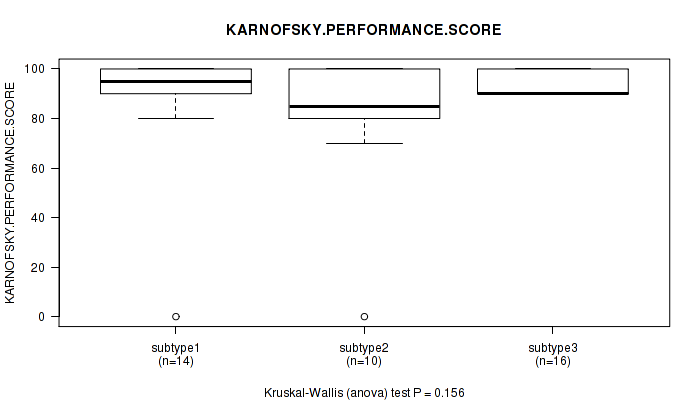
P value = 0.884 (Kruskal-Wallis (anova)), Q value = 1
Table S112. Clustering Approach #10: 'MIRSEQ CHIERARCHICAL' versus Clinical Feature #9: 'NUMBERPACKYEARSSMOKED'
| nPatients | Mean (Std.Dev) | |
|---|---|---|
| ALL | 12 | 27.2 (16.2) |
| subtype1 | 4 | 23.5 (14.0) |
| subtype2 | 5 | 27.4 (18.7) |
| subtype3 | 3 | 31.7 (19.9) |
Figure S102. Get High-res Image Clustering Approach #10: 'MIRSEQ CHIERARCHICAL' versus Clinical Feature #9: 'NUMBERPACKYEARSSMOKED'

P value = 0.14 (Fisher's exact test), Q value = 1
Table S113. Clustering Approach #10: 'MIRSEQ CHIERARCHICAL' versus Clinical Feature #10: 'RACE'
| nPatients | ASIAN | BLACK OR AFRICAN AMERICAN | WHITE |
|---|---|---|---|
| ALL | 8 | 44 | 445 |
| subtype1 | 4 | 18 | 120 |
| subtype2 | 2 | 12 | 117 |
| subtype3 | 2 | 14 | 171 |
| subtype4 | 0 | 0 | 37 |
Figure S103. Get High-res Image Clustering Approach #10: 'MIRSEQ CHIERARCHICAL' versus Clinical Feature #10: 'RACE'

P value = 0.0181 (Fisher's exact test), Q value = 1
Table S114. Clustering Approach #10: 'MIRSEQ CHIERARCHICAL' versus Clinical Feature #11: 'ETHNICITY'
| nPatients | HISPANIC OR LATINO | NOT HISPANIC OR LATINO |
|---|---|---|
| ALL | 24 | 333 |
| subtype1 | 2 | 91 |
| subtype2 | 4 | 96 |
| subtype3 | 14 | 120 |
| subtype4 | 4 | 26 |
Figure S104. Get High-res Image Clustering Approach #10: 'MIRSEQ CHIERARCHICAL' versus Clinical Feature #11: 'ETHNICITY'
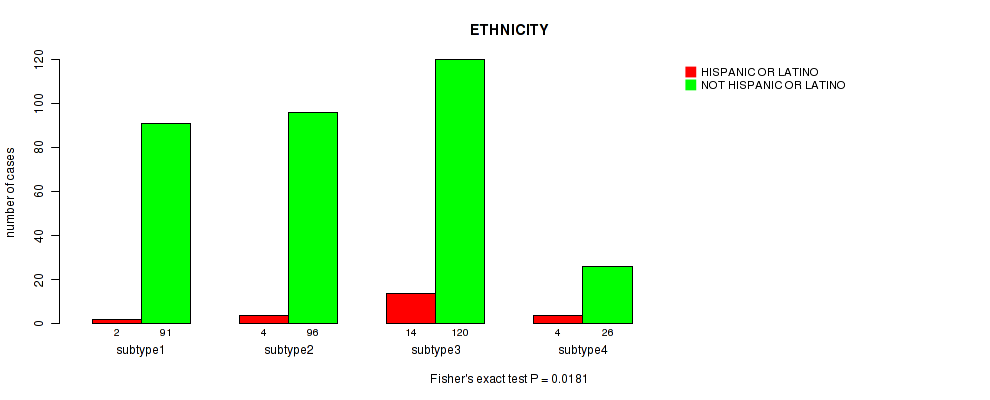
Table S115. Description of clustering approach #11: 'MIRseq Mature CNMF subtypes'
| Cluster Labels | 1 | 2 | 3 | 4 |
|---|---|---|---|---|
| Number of samples | 30 | 22 | 49 | 35 |
P value = 0.633 (logrank test), Q value = 1
Table S116. Clustering Approach #11: 'MIRseq Mature CNMF subtypes' versus Clinical Feature #1: 'Time to Death'
| nPatients | nDeath | Duration Range (Median), Year | |
|---|---|---|---|
| ALL | 99 | 6 | 3.0 - 3668.0 (1168.0) |
| subtype1 | 22 | 1 | 3.0 - 2353.0 (599.0) |
| subtype2 | 18 | 0 | 24.0 - 3431.0 (1265.0) |
| subtype3 | 41 | 4 | 25.0 - 3668.0 (1398.0) |
| subtype4 | 18 | 1 | 15.0 - 2660.0 (860.0) |
Figure S105. Get High-res Image Clustering Approach #11: 'MIRseq Mature CNMF subtypes' versus Clinical Feature #1: 'Time to Death'
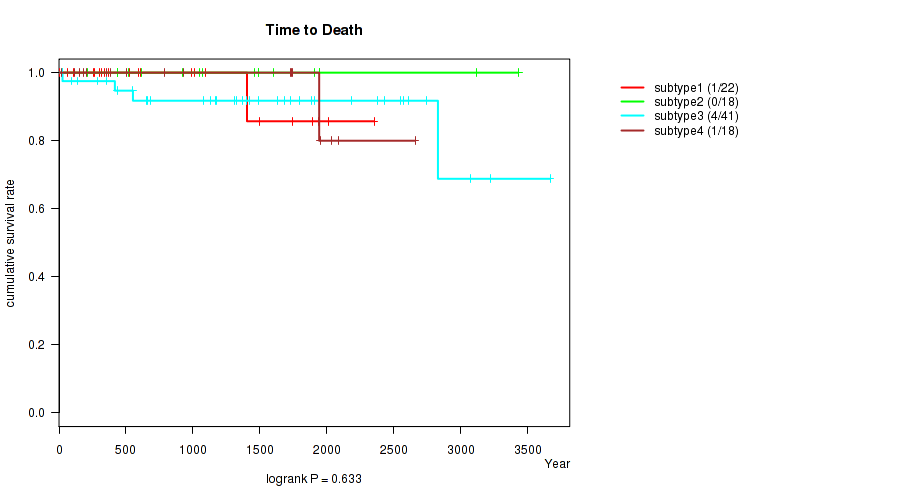
P value = 0.68 (Kruskal-Wallis (anova)), Q value = 1
Table S117. Clustering Approach #11: 'MIRseq Mature CNMF subtypes' versus Clinical Feature #2: 'AGE'
| nPatients | Mean (Std.Dev) | |
|---|---|---|
| ALL | 136 | 60.6 (11.6) |
| subtype1 | 30 | 60.3 (10.4) |
| subtype2 | 22 | 58.0 (12.0) |
| subtype3 | 49 | 61.7 (12.3) |
| subtype4 | 35 | 61.2 (11.3) |
Figure S106. Get High-res Image Clustering Approach #11: 'MIRseq Mature CNMF subtypes' versus Clinical Feature #2: 'AGE'
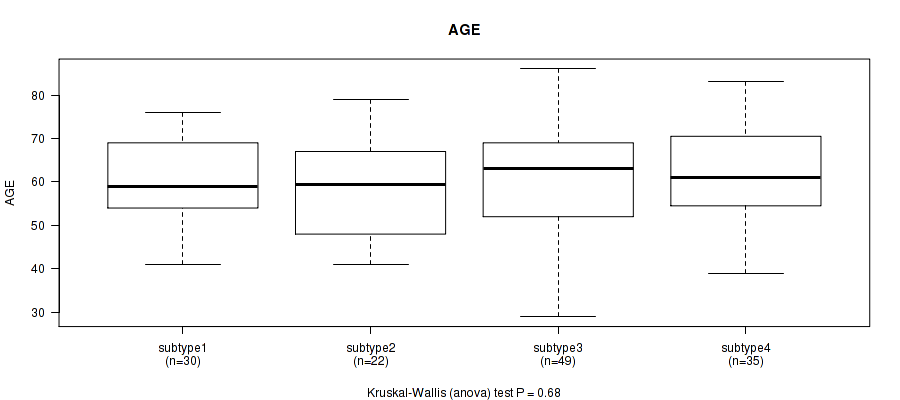
P value = 0.343 (Fisher's exact test), Q value = 1
Table S118. Clustering Approach #11: 'MIRseq Mature CNMF subtypes' versus Clinical Feature #3: 'NEOPLASM.DISEASESTAGE'
| nPatients | STAGE I | STAGE II | STAGE III | STAGE IV |
|---|---|---|---|---|
| ALL | 68 | 17 | 25 | 26 |
| subtype1 | 17 | 5 | 3 | 5 |
| subtype2 | 15 | 1 | 4 | 2 |
| subtype3 | 22 | 7 | 12 | 8 |
| subtype4 | 14 | 4 | 6 | 11 |
Figure S107. Get High-res Image Clustering Approach #11: 'MIRseq Mature CNMF subtypes' versus Clinical Feature #3: 'NEOPLASM.DISEASESTAGE'

P value = 0.116 (Fisher's exact test), Q value = 1
Table S119. Clustering Approach #11: 'MIRseq Mature CNMF subtypes' versus Clinical Feature #4: 'PATHOLOGY.T.STAGE'
| nPatients | T1 | T2 | T3 | T4 |
|---|---|---|---|---|
| ALL | 70 | 19 | 42 | 5 |
| subtype1 | 17 | 6 | 6 | 1 |
| subtype2 | 16 | 1 | 4 | 1 |
| subtype3 | 22 | 8 | 19 | 0 |
| subtype4 | 15 | 4 | 13 | 3 |
Figure S108. Get High-res Image Clustering Approach #11: 'MIRseq Mature CNMF subtypes' versus Clinical Feature #4: 'PATHOLOGY.T.STAGE'

P value = 0.172 (Fisher's exact test), Q value = 1
Table S120. Clustering Approach #11: 'MIRseq Mature CNMF subtypes' versus Clinical Feature #5: 'PATHOLOGY.N.STAGE'
| nPatients | 0 | 1 |
|---|---|---|
| ALL | 55 | 5 |
| subtype1 | 6 | 1 |
| subtype2 | 9 | 1 |
| subtype3 | 23 | 0 |
| subtype4 | 17 | 3 |
Figure S109. Get High-res Image Clustering Approach #11: 'MIRseq Mature CNMF subtypes' versus Clinical Feature #5: 'PATHOLOGY.N.STAGE'
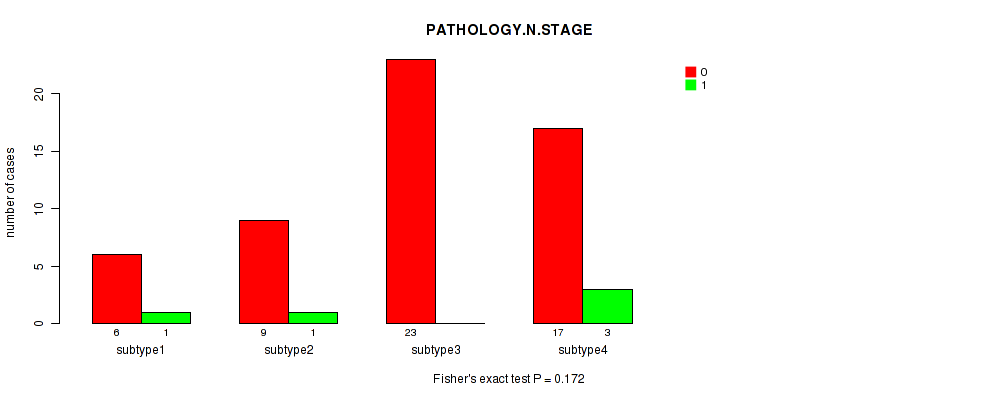
P value = 1e-05 (Fisher's exact test), Q value = 0.0012
Table S121. Clustering Approach #11: 'MIRseq Mature CNMF subtypes' versus Clinical Feature #6: 'PATHOLOGY.M.STAGE'
| nPatients | M0 | M1 | MX |
|---|---|---|---|
| ALL | 97 | 23 | 14 |
| subtype1 | 13 | 4 | 12 |
| subtype2 | 20 | 1 | 0 |
| subtype3 | 41 | 8 | 0 |
| subtype4 | 23 | 10 | 2 |
Figure S110. Get High-res Image Clustering Approach #11: 'MIRseq Mature CNMF subtypes' versus Clinical Feature #6: 'PATHOLOGY.M.STAGE'

P value = 0.0251 (Fisher's exact test), Q value = 1
Table S122. Clustering Approach #11: 'MIRseq Mature CNMF subtypes' versus Clinical Feature #7: 'GENDER'
| nPatients | FEMALE | MALE |
|---|---|---|
| ALL | 47 | 89 |
| subtype1 | 15 | 15 |
| subtype2 | 6 | 16 |
| subtype3 | 20 | 29 |
| subtype4 | 6 | 29 |
Figure S111. Get High-res Image Clustering Approach #11: 'MIRseq Mature CNMF subtypes' versus Clinical Feature #7: 'GENDER'

P value = 0.994 (Kruskal-Wallis (anova)), Q value = 1
Table S123. Clustering Approach #11: 'MIRseq Mature CNMF subtypes' versus Clinical Feature #8: 'KARNOFSKY.PERFORMANCE.SCORE'
| nPatients | Mean (Std.Dev) | |
|---|---|---|
| ALL | 18 | 92.8 (8.3) |
| subtype1 | 5 | 94.0 (5.5) |
| subtype3 | 9 | 92.2 (9.7) |
| subtype4 | 4 | 92.5 (9.6) |
Figure S112. Get High-res Image Clustering Approach #11: 'MIRseq Mature CNMF subtypes' versus Clinical Feature #8: 'KARNOFSKY.PERFORMANCE.SCORE'
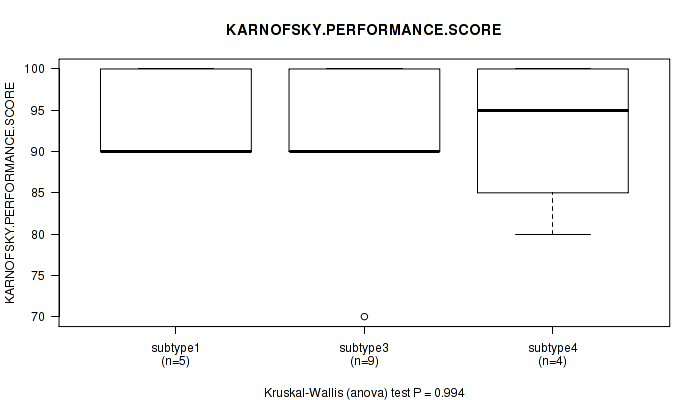
P value = 1e-05 (Fisher's exact test), Q value = 0.0012
Table S124. Clustering Approach #11: 'MIRseq Mature CNMF subtypes' versus Clinical Feature #10: 'RACE'
| nPatients | ASIAN | BLACK OR AFRICAN AMERICAN | WHITE |
|---|---|---|---|
| ALL | 3 | 22 | 108 |
| subtype1 | 0 | 16 | 14 |
| subtype2 | 1 | 2 | 18 |
| subtype3 | 0 | 0 | 48 |
| subtype4 | 2 | 4 | 28 |
Figure S113. Get High-res Image Clustering Approach #11: 'MIRseq Mature CNMF subtypes' versus Clinical Feature #10: 'RACE'

P value = 0.454 (Fisher's exact test), Q value = 1
Table S125. Clustering Approach #11: 'MIRseq Mature CNMF subtypes' versus Clinical Feature #11: 'ETHNICITY'
| nPatients | HISPANIC OR LATINO | NOT HISPANIC OR LATINO |
|---|---|---|
| ALL | 6 | 96 |
| subtype1 | 0 | 24 |
| subtype2 | 1 | 13 |
| subtype3 | 4 | 37 |
| subtype4 | 1 | 22 |
Figure S114. Get High-res Image Clustering Approach #11: 'MIRseq Mature CNMF subtypes' versus Clinical Feature #11: 'ETHNICITY'
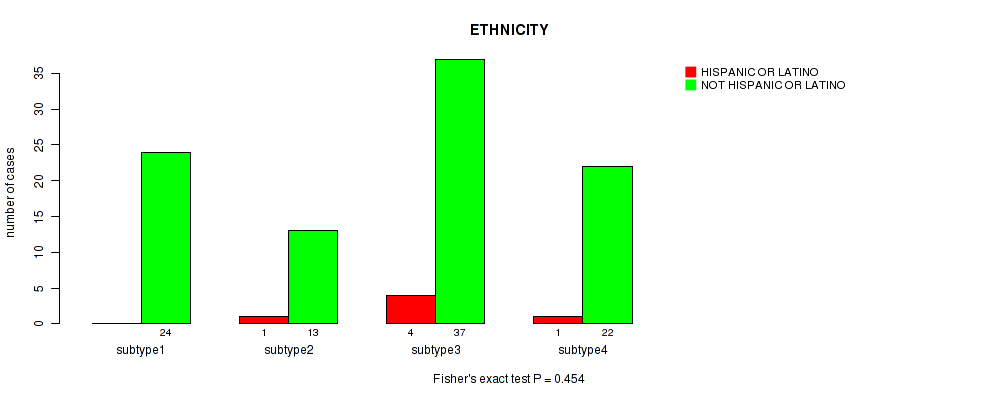
Table S126. Description of clustering approach #12: 'MIRseq Mature cHierClus subtypes'
| Cluster Labels | 1 | 2 | 3 |
|---|---|---|---|
| Number of samples | 32 | 56 | 48 |
P value = 0.43 (logrank test), Q value = 1
Table S127. Clustering Approach #12: 'MIRseq Mature cHierClus subtypes' versus Clinical Feature #1: 'Time to Death'
| nPatients | nDeath | Duration Range (Median), Year | |
|---|---|---|---|
| ALL | 99 | 6 | 3.0 - 3668.0 (1168.0) |
| subtype1 | 24 | 1 | 3.0 - 2353.0 (723.5) |
| subtype2 | 36 | 1 | 15.0 - 3431.0 (1328.5) |
| subtype3 | 39 | 4 | 25.0 - 3668.0 (1371.0) |
Figure S115. Get High-res Image Clustering Approach #12: 'MIRseq Mature cHierClus subtypes' versus Clinical Feature #1: 'Time to Death'
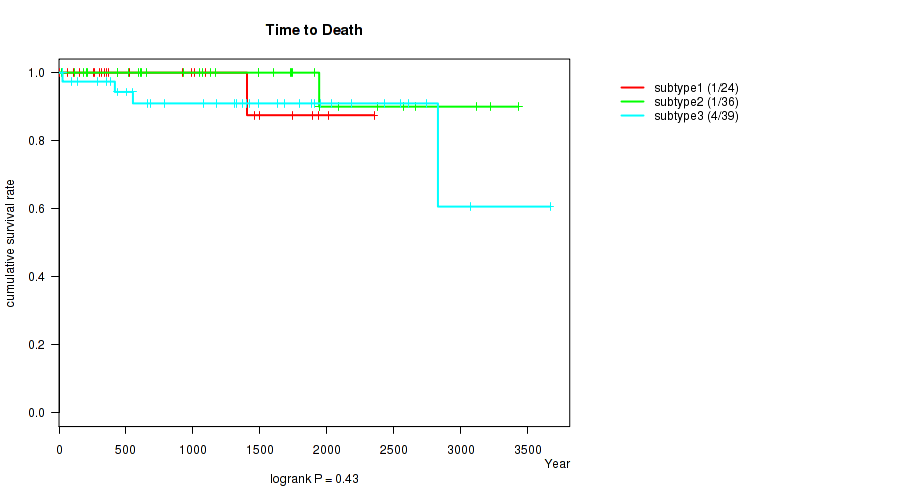
P value = 0.0614 (Kruskal-Wallis (anova)), Q value = 1
Table S128. Clustering Approach #12: 'MIRseq Mature cHierClus subtypes' versus Clinical Feature #2: 'AGE'
| nPatients | Mean (Std.Dev) | |
|---|---|---|
| ALL | 136 | 60.6 (11.6) |
| subtype1 | 32 | 60.7 (10.2) |
| subtype2 | 56 | 58.1 (11.7) |
| subtype3 | 48 | 63.6 (11.8) |
Figure S116. Get High-res Image Clustering Approach #12: 'MIRseq Mature cHierClus subtypes' versus Clinical Feature #2: 'AGE'
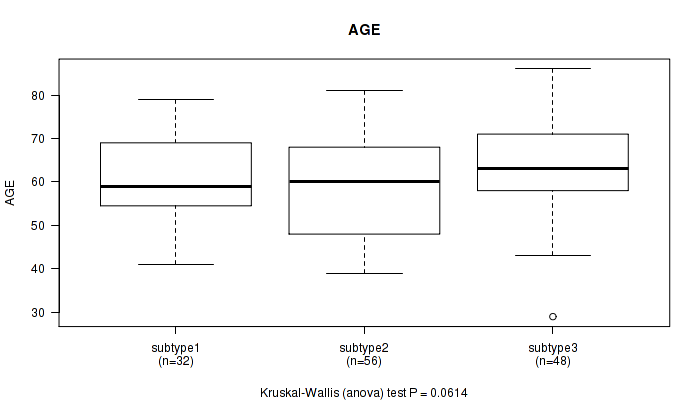
P value = 0.342 (Fisher's exact test), Q value = 1
Table S129. Clustering Approach #12: 'MIRseq Mature cHierClus subtypes' versus Clinical Feature #3: 'NEOPLASM.DISEASESTAGE'
| nPatients | STAGE I | STAGE II | STAGE III | STAGE IV |
|---|---|---|---|---|
| ALL | 68 | 17 | 25 | 26 |
| subtype1 | 20 | 4 | 3 | 5 |
| subtype2 | 27 | 4 | 12 | 13 |
| subtype3 | 21 | 9 | 10 | 8 |
Figure S117. Get High-res Image Clustering Approach #12: 'MIRseq Mature cHierClus subtypes' versus Clinical Feature #3: 'NEOPLASM.DISEASESTAGE'

P value = 0.0441 (Fisher's exact test), Q value = 1
Table S130. Clustering Approach #12: 'MIRseq Mature cHierClus subtypes' versus Clinical Feature #4: 'PATHOLOGY.T.STAGE'
| nPatients | T1 | T2 | T3 | T4 |
|---|---|---|---|---|
| ALL | 70 | 19 | 42 | 5 |
| subtype1 | 21 | 5 | 5 | 1 |
| subtype2 | 27 | 4 | 21 | 4 |
| subtype3 | 22 | 10 | 16 | 0 |
Figure S118. Get High-res Image Clustering Approach #12: 'MIRseq Mature cHierClus subtypes' versus Clinical Feature #4: 'PATHOLOGY.T.STAGE'

P value = 0.16 (Fisher's exact test), Q value = 1
Table S131. Clustering Approach #12: 'MIRseq Mature cHierClus subtypes' versus Clinical Feature #5: 'PATHOLOGY.N.STAGE'
| nPatients | 0 | 1 |
|---|---|---|
| ALL | 55 | 5 |
| subtype1 | 7 | 1 |
| subtype2 | 26 | 4 |
| subtype3 | 22 | 0 |
Figure S119. Get High-res Image Clustering Approach #12: 'MIRseq Mature cHierClus subtypes' versus Clinical Feature #5: 'PATHOLOGY.N.STAGE'
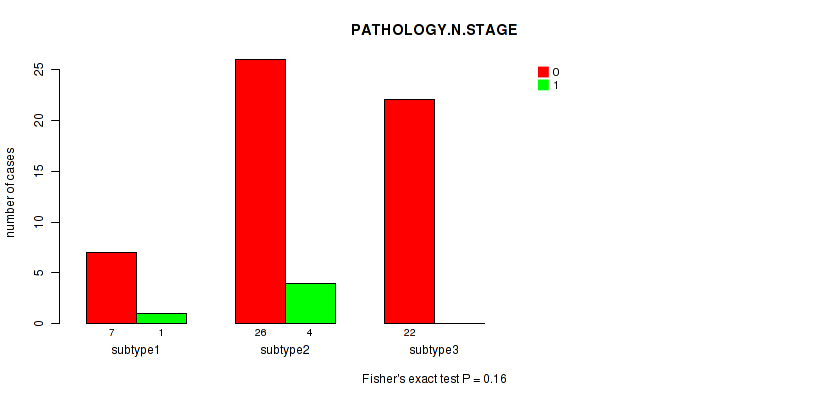
P value = 6e-05 (Fisher's exact test), Q value = 0.0061
Table S132. Clustering Approach #12: 'MIRseq Mature cHierClus subtypes' versus Clinical Feature #6: 'PATHOLOGY.M.STAGE'
| nPatients | M0 | M1 | MX |
|---|---|---|---|
| ALL | 97 | 23 | 14 |
| subtype1 | 16 | 4 | 11 |
| subtype2 | 41 | 11 | 3 |
| subtype3 | 40 | 8 | 0 |
Figure S120. Get High-res Image Clustering Approach #12: 'MIRseq Mature cHierClus subtypes' versus Clinical Feature #6: 'PATHOLOGY.M.STAGE'
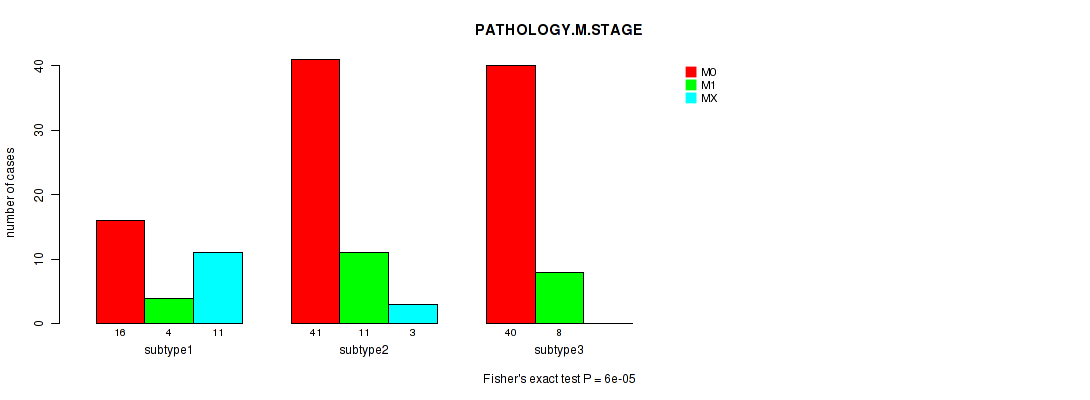
P value = 0.00216 (Fisher's exact test), Q value = 0.19
Table S133. Clustering Approach #12: 'MIRseq Mature cHierClus subtypes' versus Clinical Feature #7: 'GENDER'
| nPatients | FEMALE | MALE |
|---|---|---|
| ALL | 47 | 89 |
| subtype1 | 15 | 17 |
| subtype2 | 10 | 46 |
| subtype3 | 22 | 26 |
Figure S121. Get High-res Image Clustering Approach #12: 'MIRseq Mature cHierClus subtypes' versus Clinical Feature #7: 'GENDER'
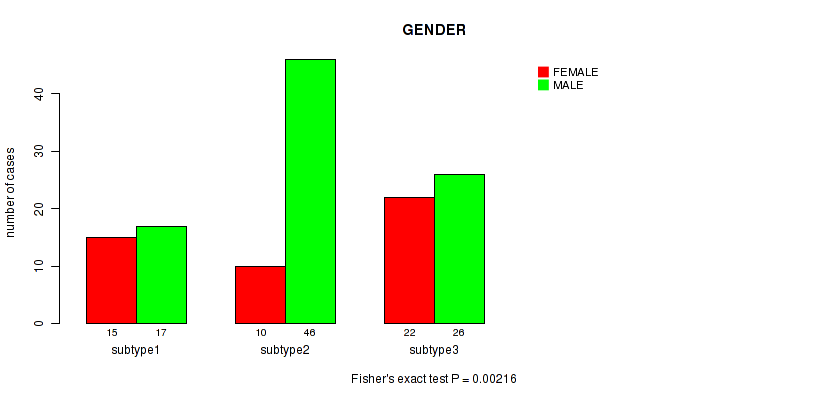
P value = 0.843 (Kruskal-Wallis (anova)), Q value = 1
Table S134. Clustering Approach #12: 'MIRseq Mature cHierClus subtypes' versus Clinical Feature #8: 'KARNOFSKY.PERFORMANCE.SCORE'
| nPatients | Mean (Std.Dev) | |
|---|---|---|
| ALL | 18 | 92.8 (8.3) |
| subtype1 | 5 | 94.0 (5.5) |
| subtype2 | 5 | 94.0 (8.9) |
| subtype3 | 8 | 91.2 (9.9) |
Figure S122. Get High-res Image Clustering Approach #12: 'MIRseq Mature cHierClus subtypes' versus Clinical Feature #8: 'KARNOFSKY.PERFORMANCE.SCORE'
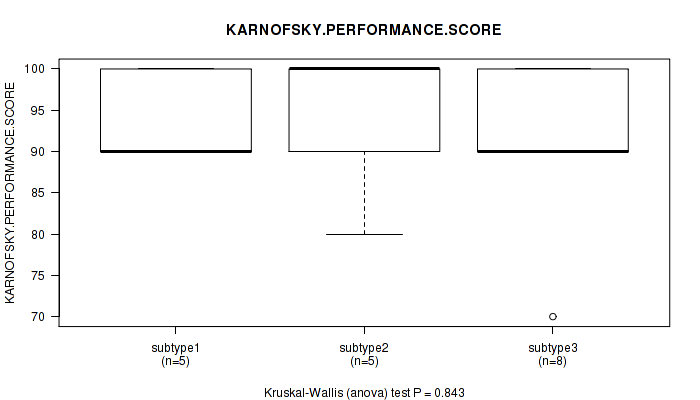
P value = 1e-05 (Fisher's exact test), Q value = 0.0012
Table S135. Clustering Approach #12: 'MIRseq Mature cHierClus subtypes' versus Clinical Feature #10: 'RACE'
| nPatients | ASIAN | BLACK OR AFRICAN AMERICAN | WHITE |
|---|---|---|---|
| ALL | 3 | 22 | 108 |
| subtype1 | 0 | 15 | 17 |
| subtype2 | 3 | 6 | 46 |
| subtype3 | 0 | 1 | 45 |
Figure S123. Get High-res Image Clustering Approach #12: 'MIRseq Mature cHierClus subtypes' versus Clinical Feature #10: 'RACE'

P value = 0.387 (Fisher's exact test), Q value = 1
Table S136. Clustering Approach #12: 'MIRseq Mature cHierClus subtypes' versus Clinical Feature #11: 'ETHNICITY'
| nPatients | HISPANIC OR LATINO | NOT HISPANIC OR LATINO |
|---|---|---|
| ALL | 6 | 96 |
| subtype1 | 0 | 26 |
| subtype2 | 3 | 35 |
| subtype3 | 3 | 35 |
Figure S124. Get High-res Image Clustering Approach #12: 'MIRseq Mature cHierClus subtypes' versus Clinical Feature #11: 'ETHNICITY'
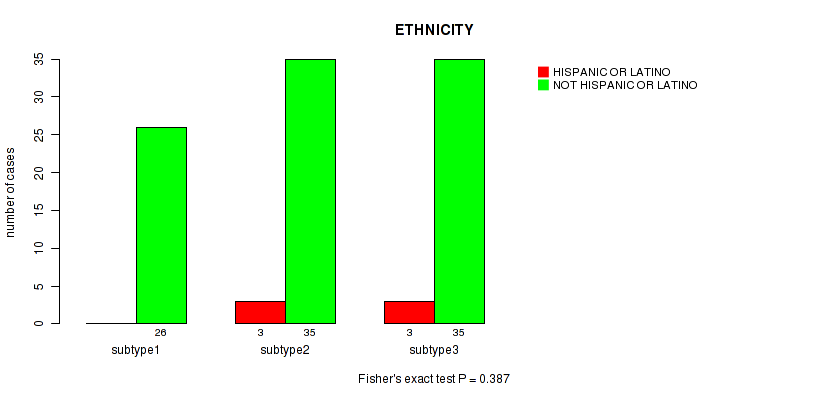
-
Cluster data file = KIRC-TP.mergedcluster.txt
-
Clinical data file = KIRC-TP.merged_data.txt
-
Number of patients = 525
-
Number of clustering approaches = 12
-
Number of selected clinical features = 11
-
Exclude small clusters that include fewer than K patients, K = 3
consensus non-negative matrix factorization clustering approach (Brunet et al. 2004)
Resampling-based clustering method (Monti et al. 2003)
For survival clinical features, the Kaplan-Meier survival curves of tumors with and without gene mutations were plotted and the statistical significance P values were estimated by logrank test (Bland and Altman 2004) using the 'survdiff' function in R
For binary clinical features, two-tailed Fisher's exact tests (Fisher 1922) were used to estimate the P values using the 'fisher.test' function in R
For multiple hypothesis correction, Q value is the False Discovery Rate (FDR) analogue of the P value (Benjamini and Hochberg 1995), defined as the minimum FDR at which the test may be called significant. We used the 'Benjamini and Hochberg' method of 'p.adjust' function in R to convert P values into Q values.
In addition to the links below, the full results of the analysis summarized in this report can also be downloaded programmatically using firehose_get, or interactively from either the Broad GDAC website or TCGA Data Coordination Center Portal.